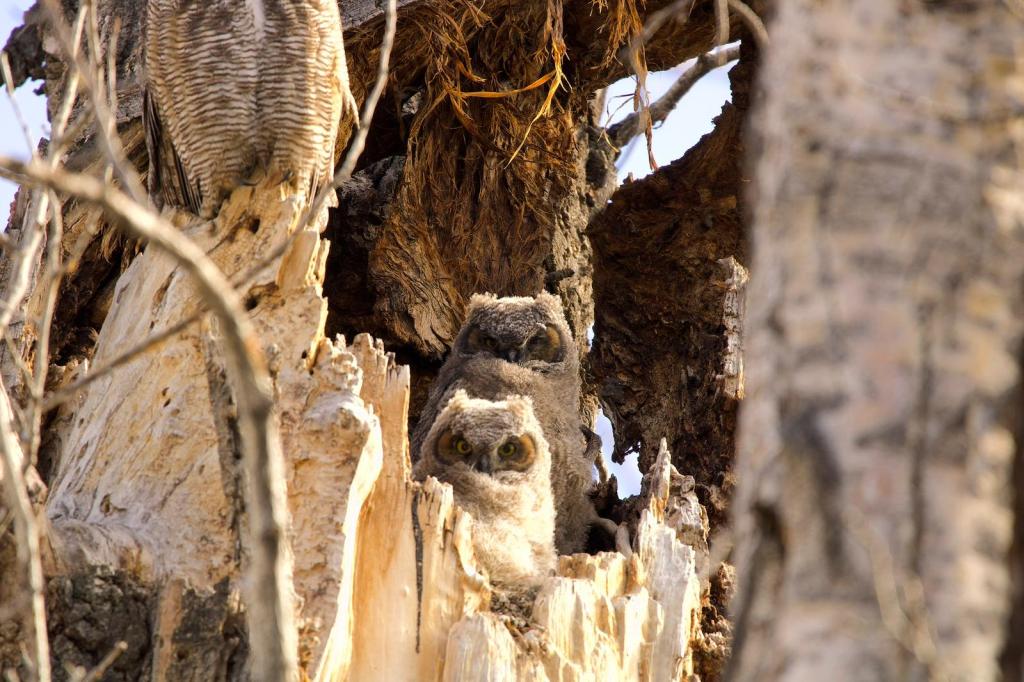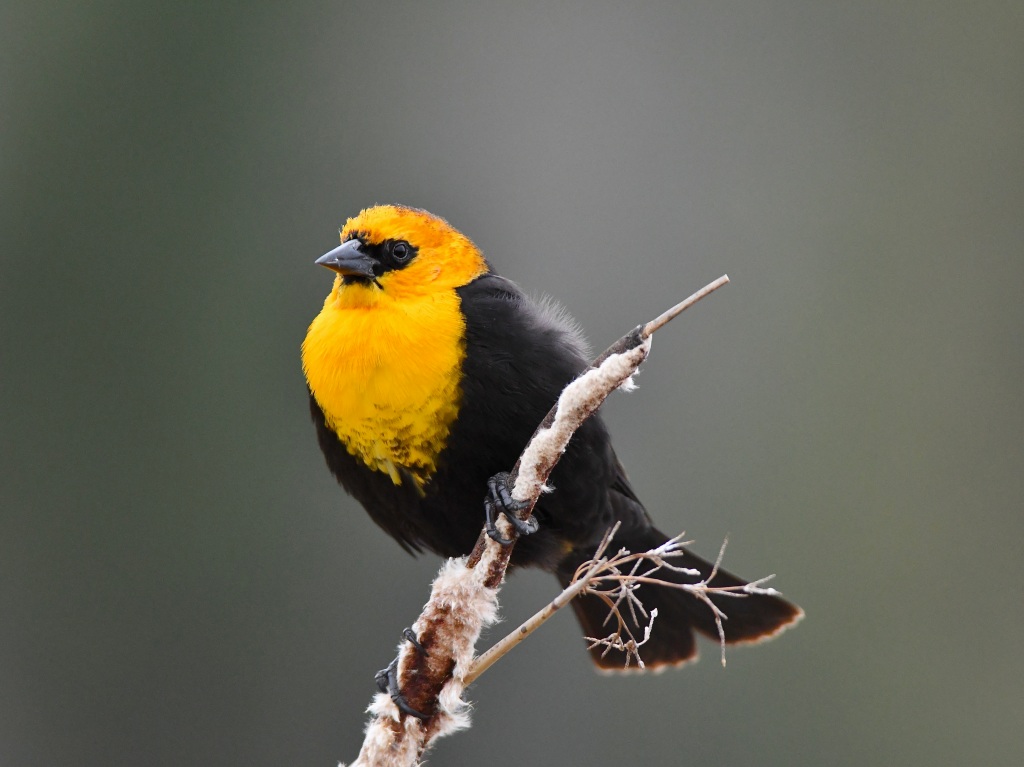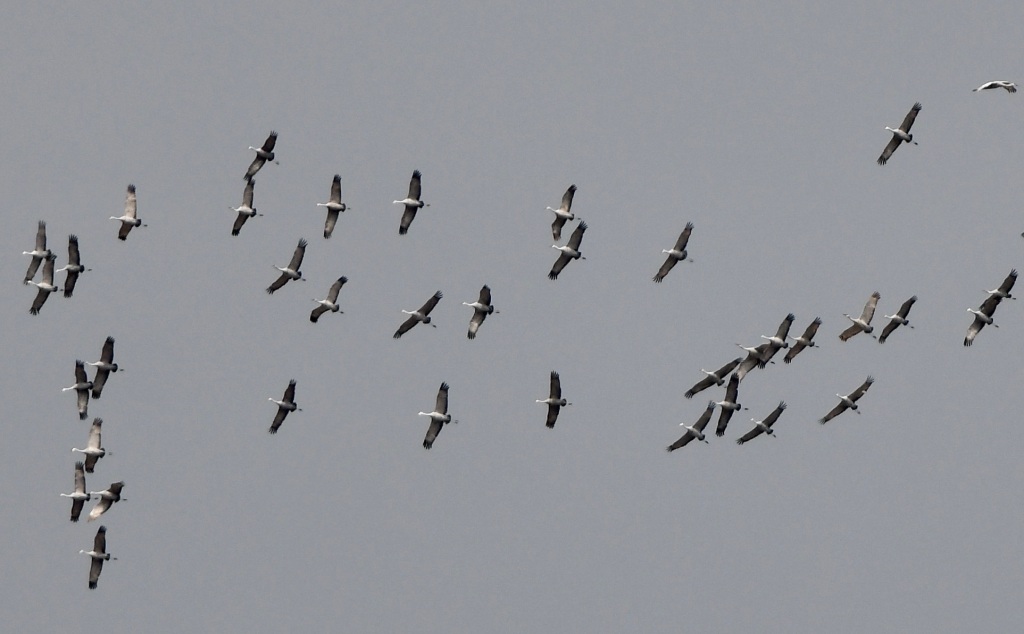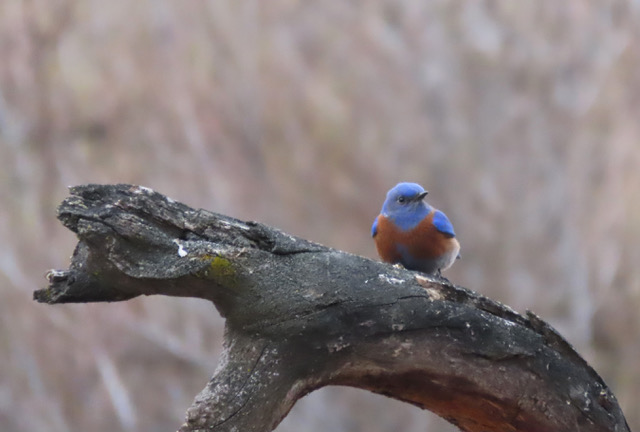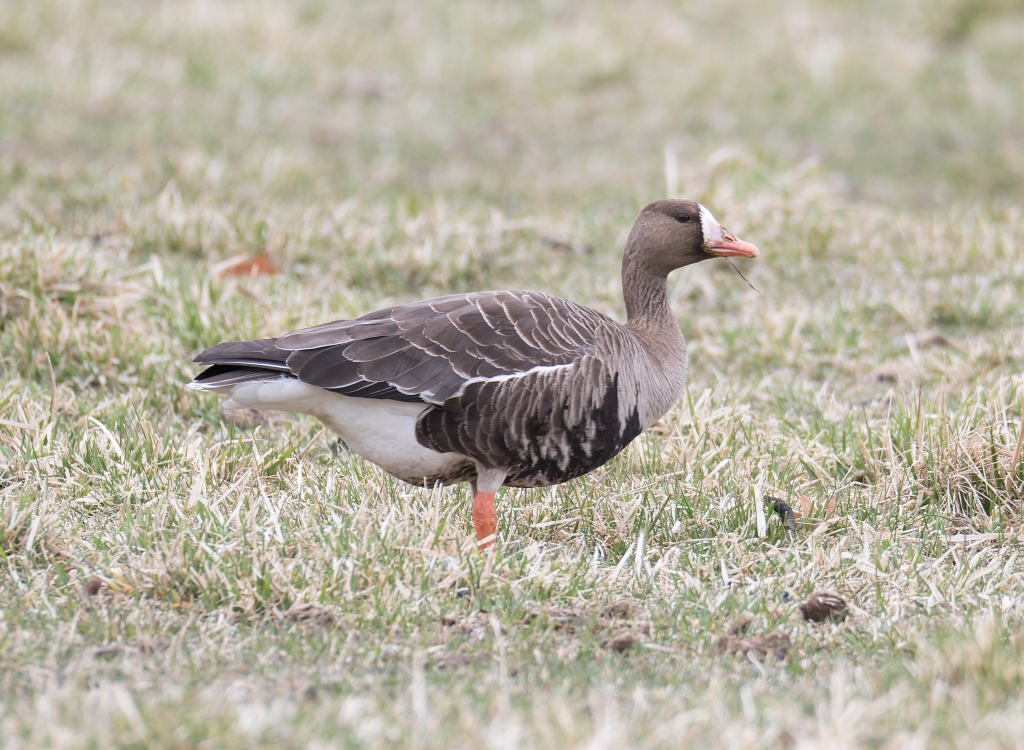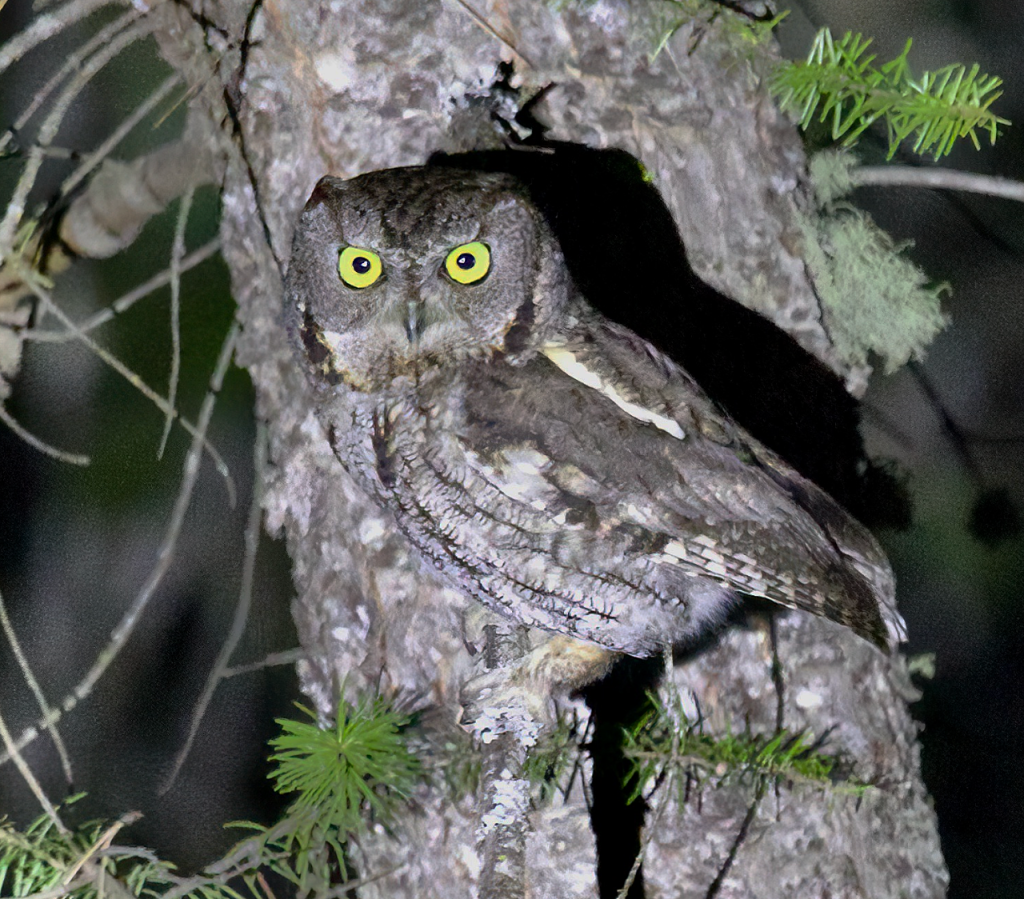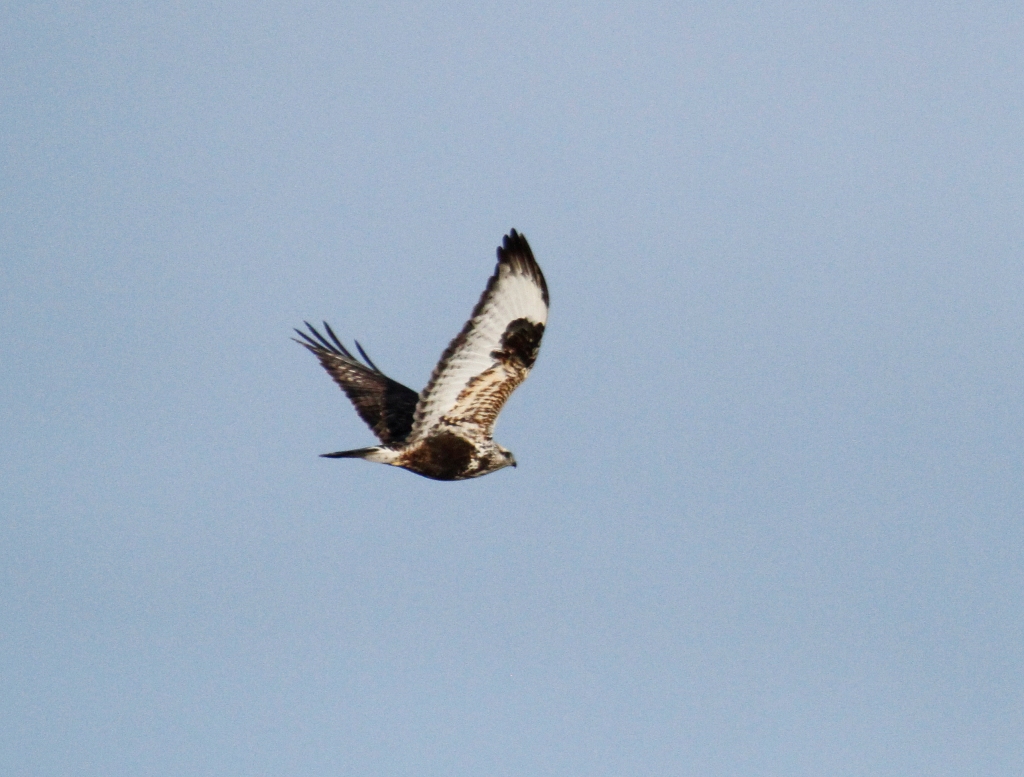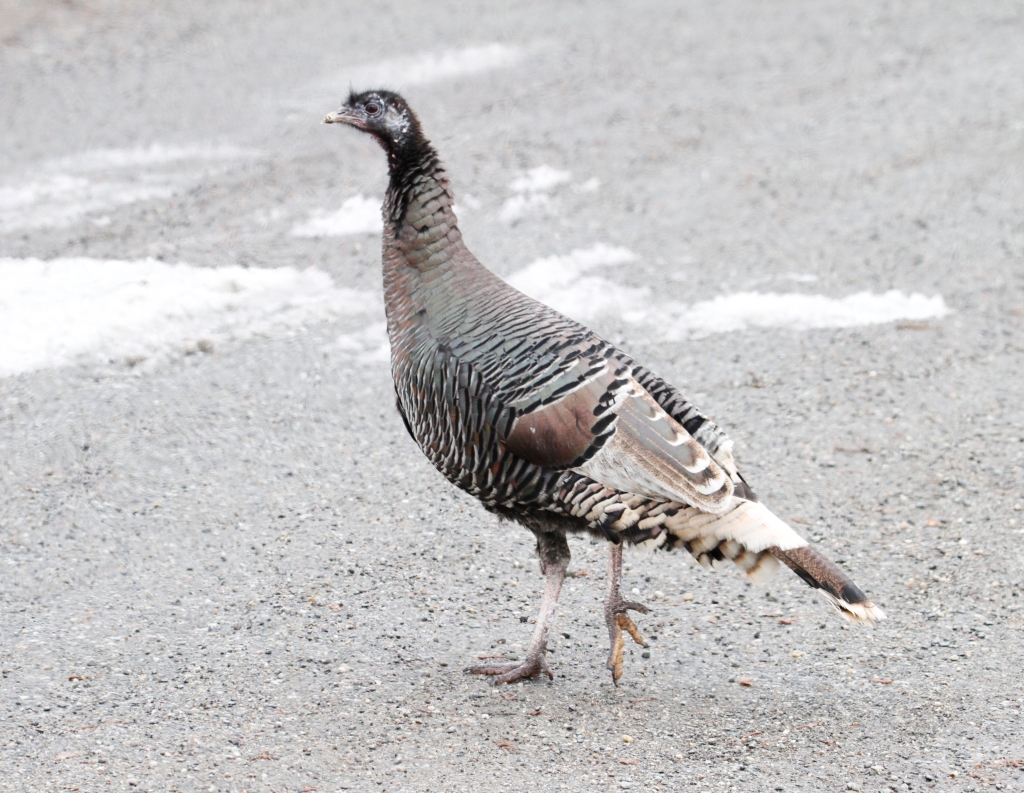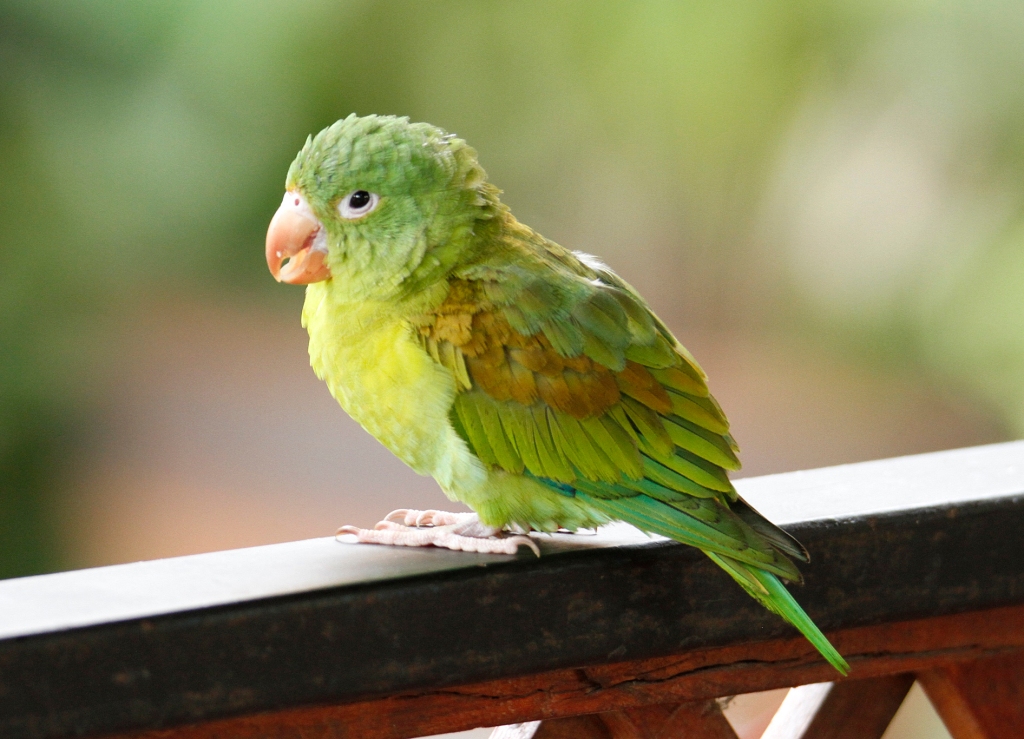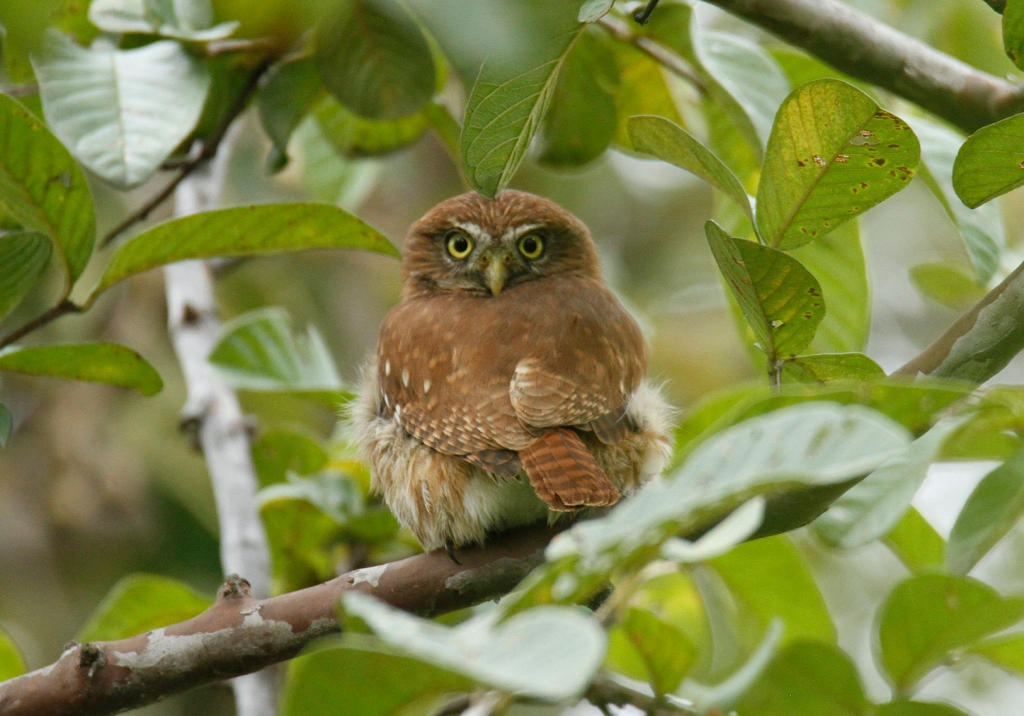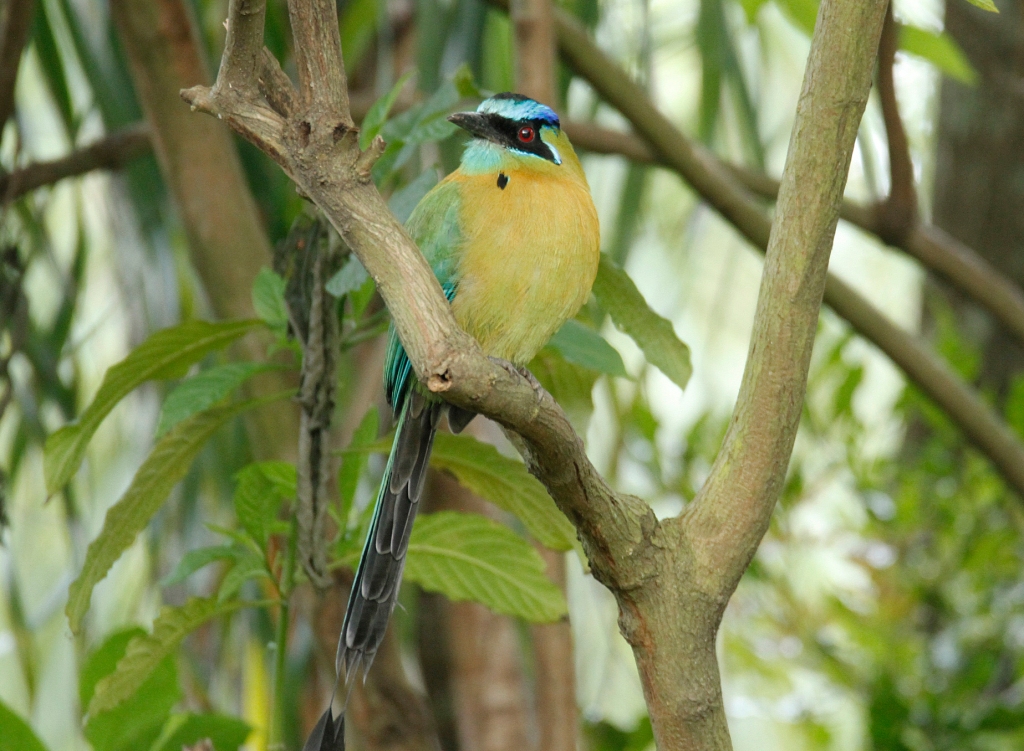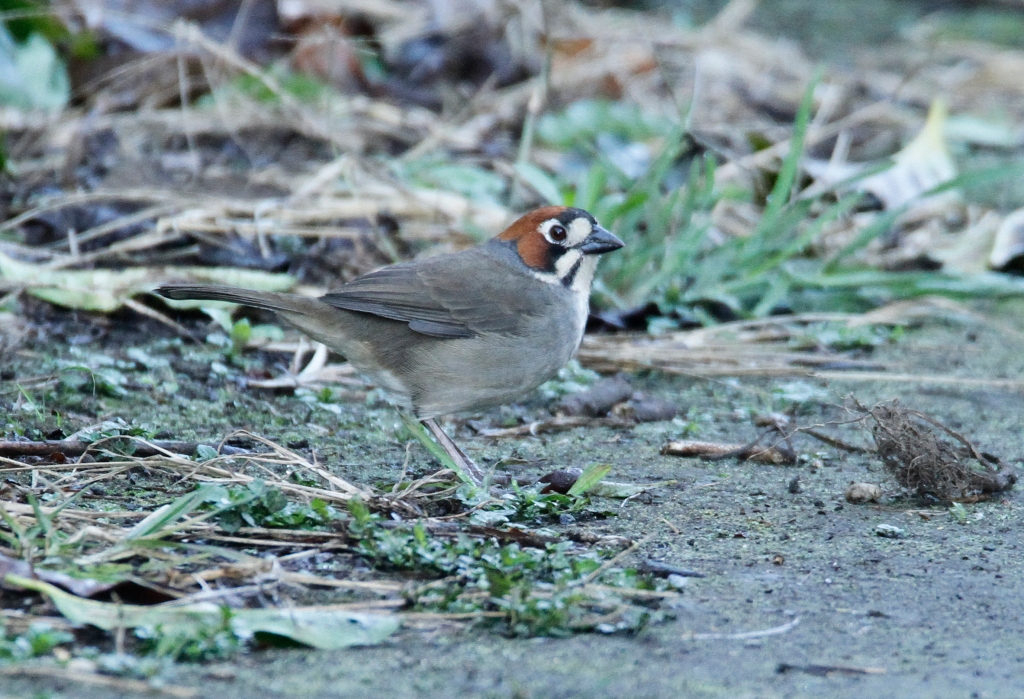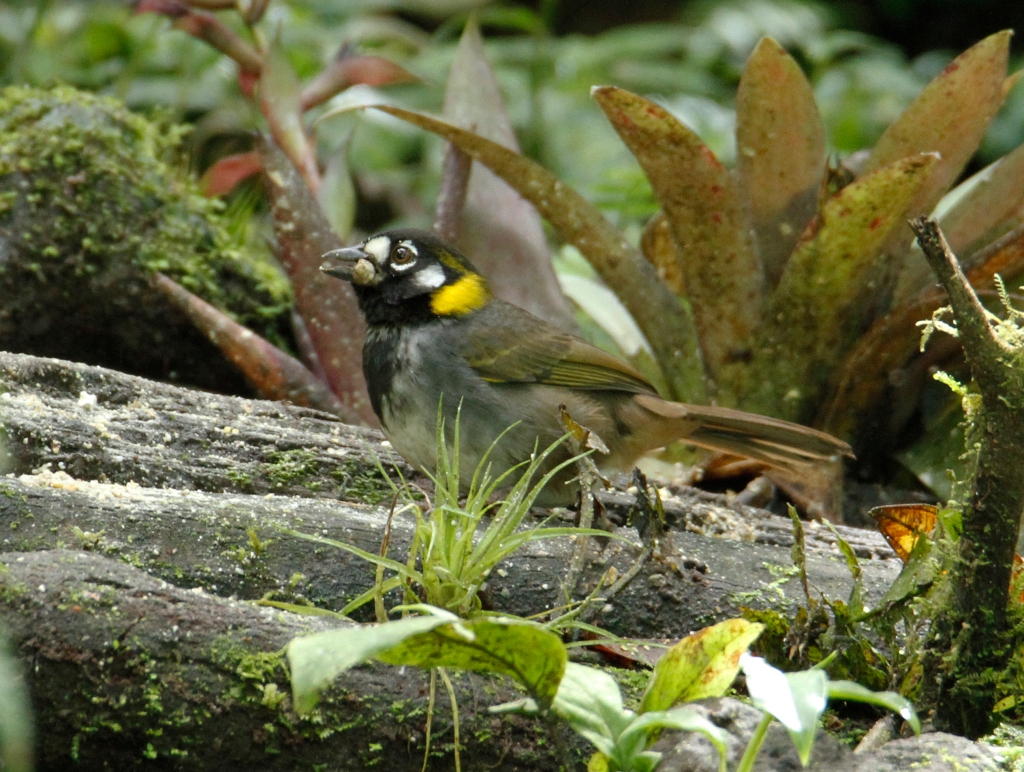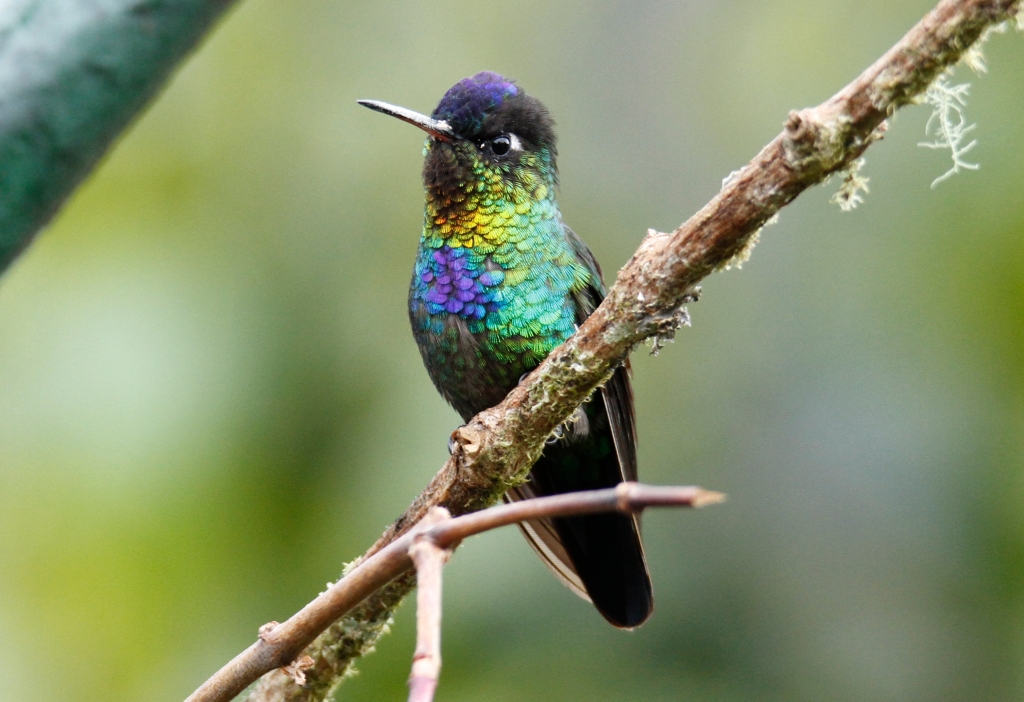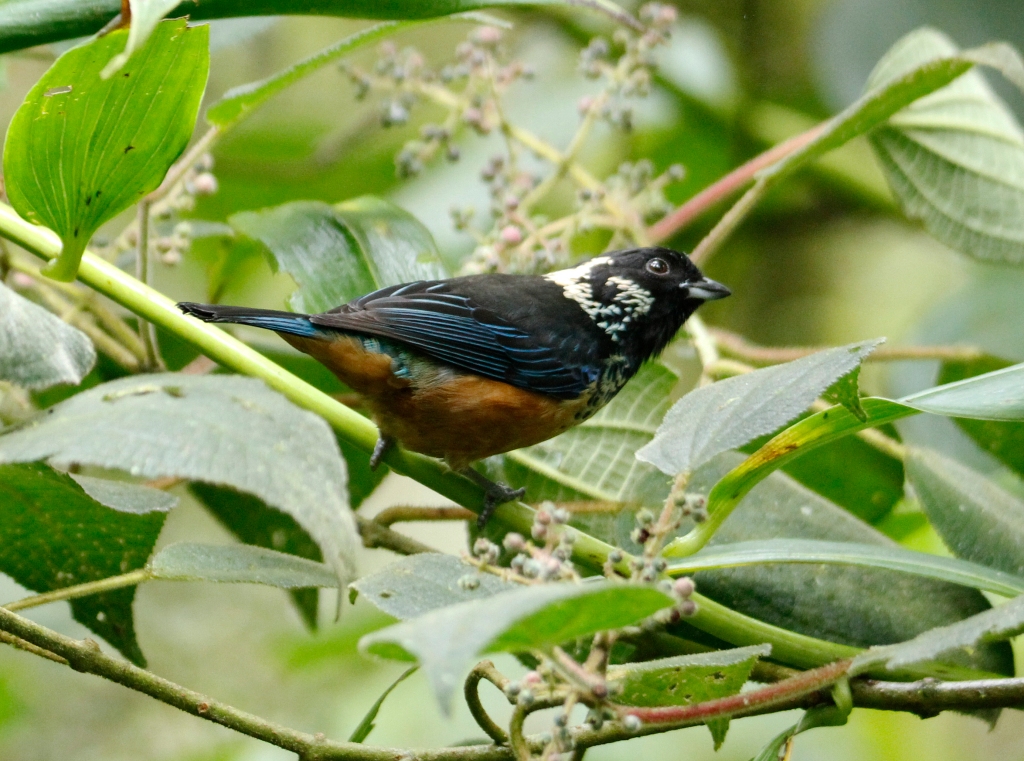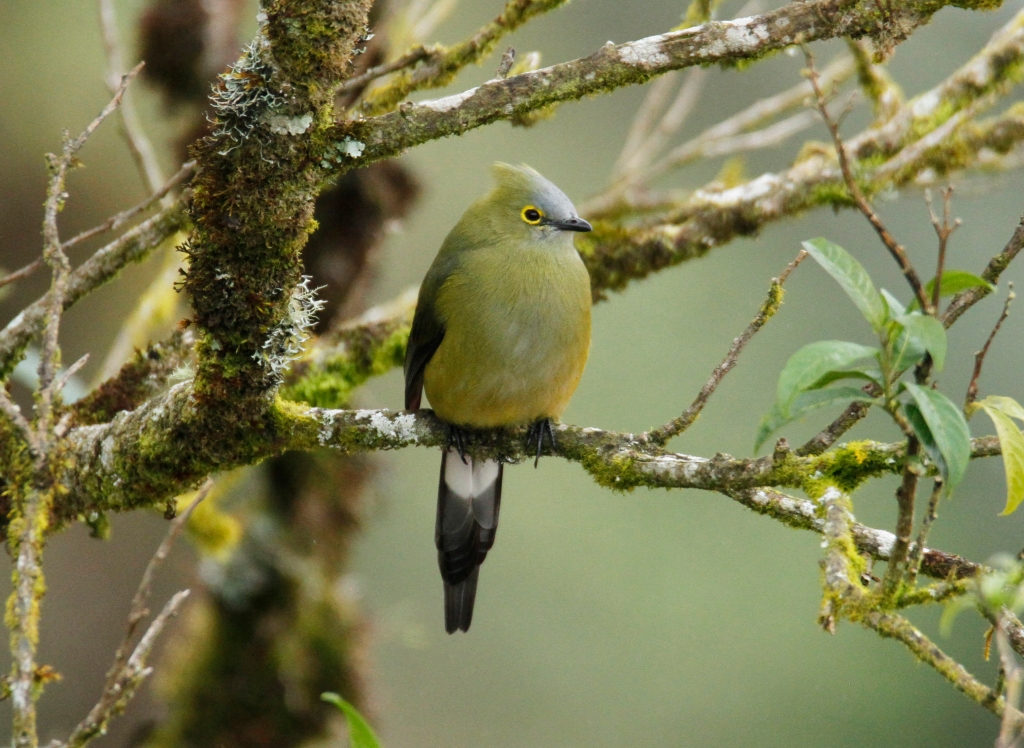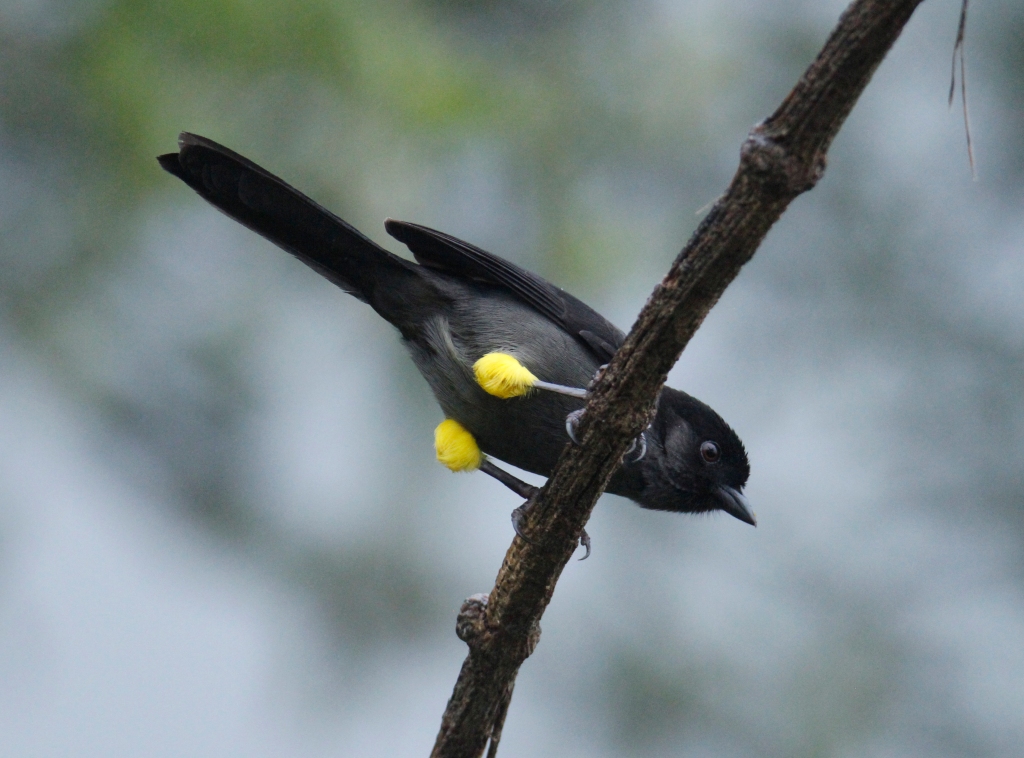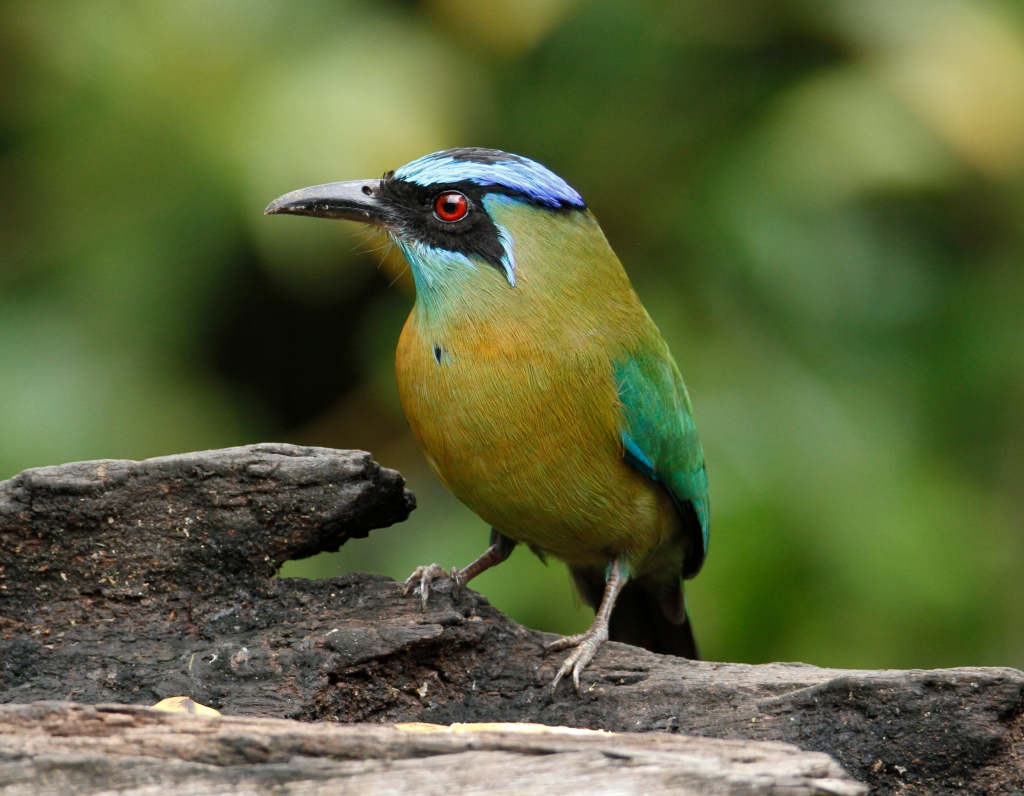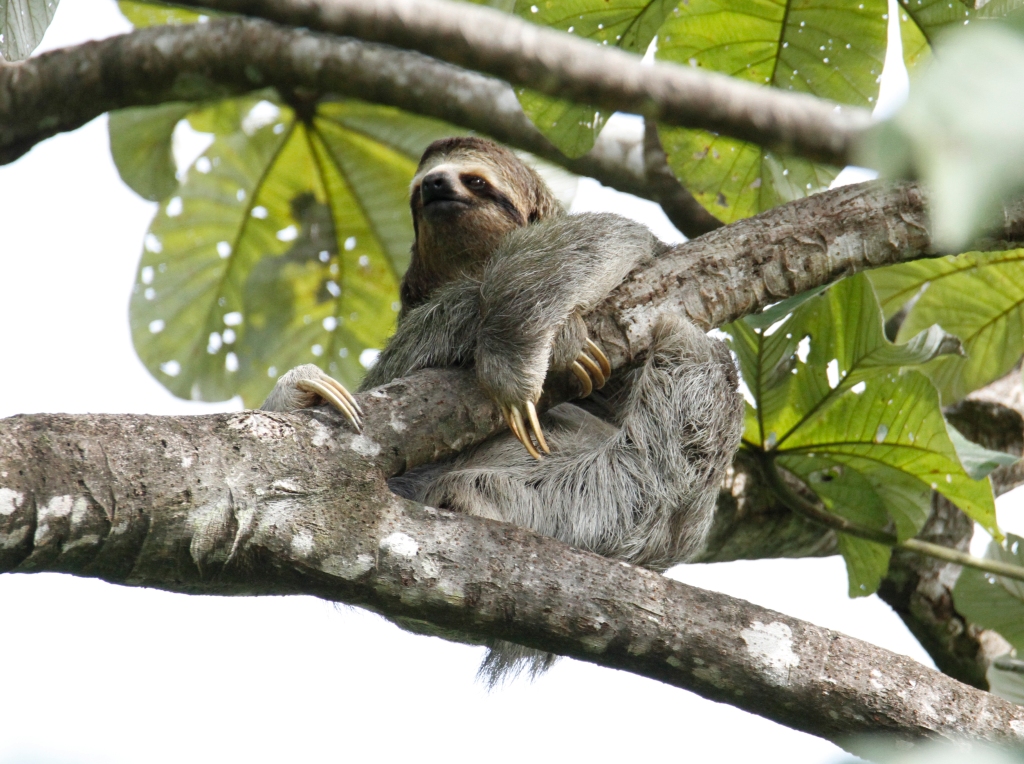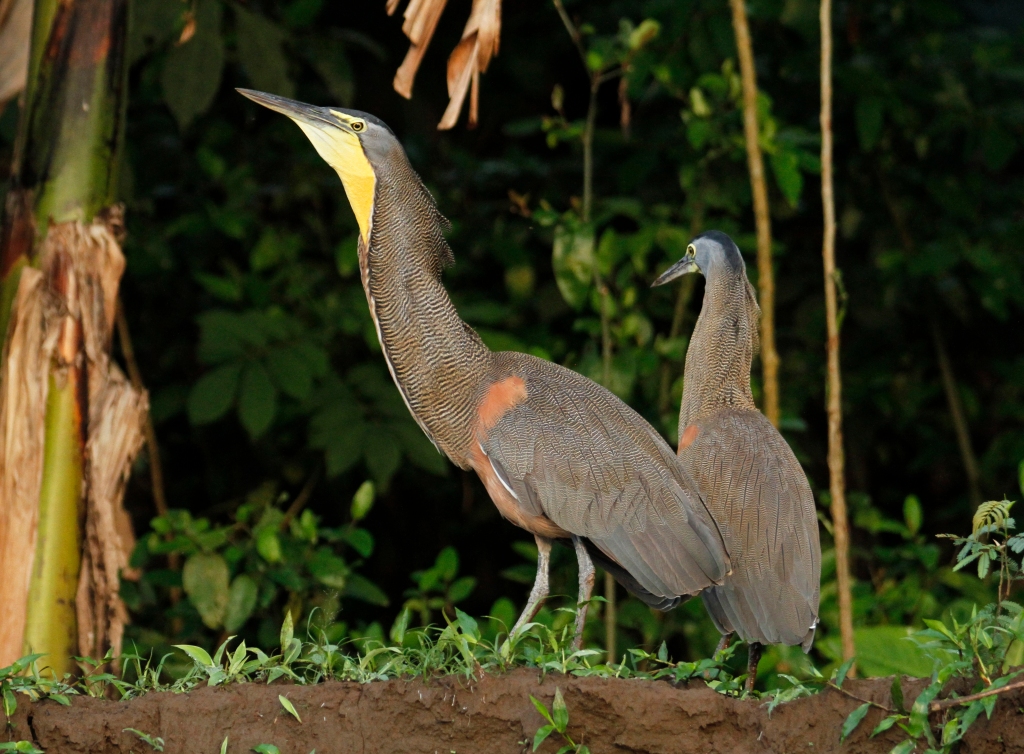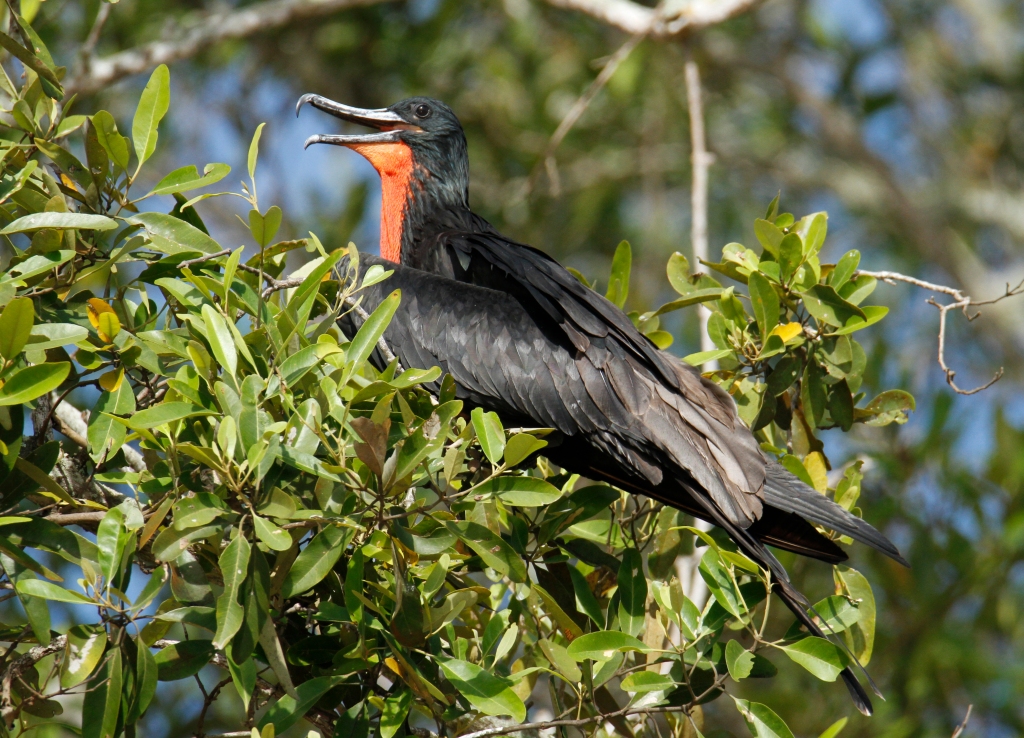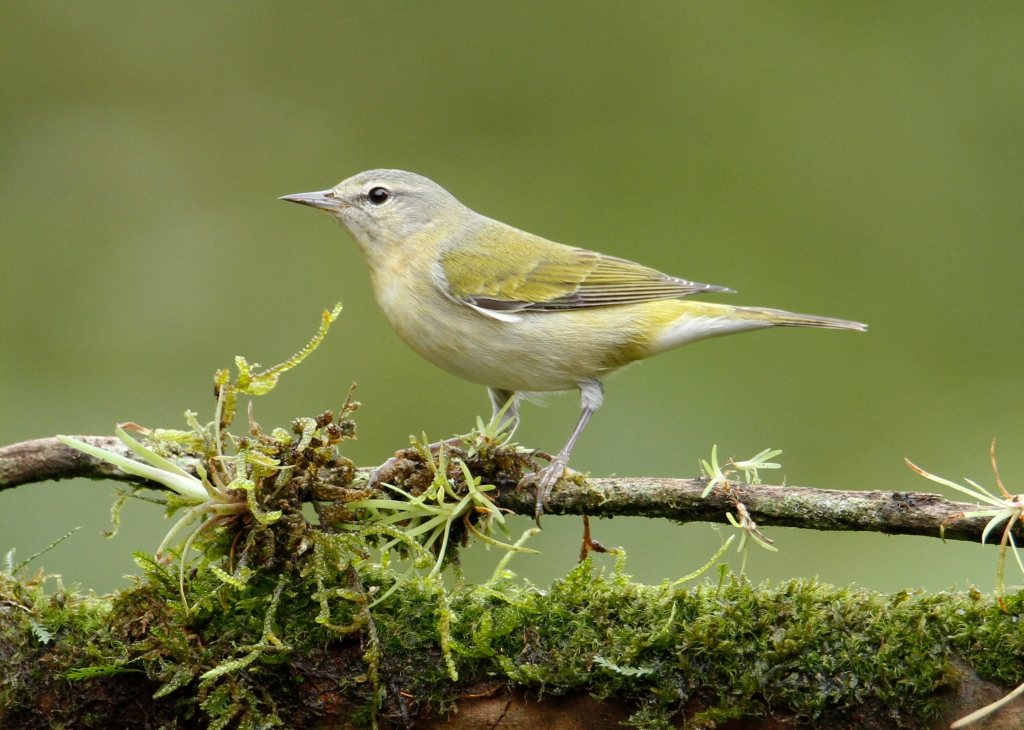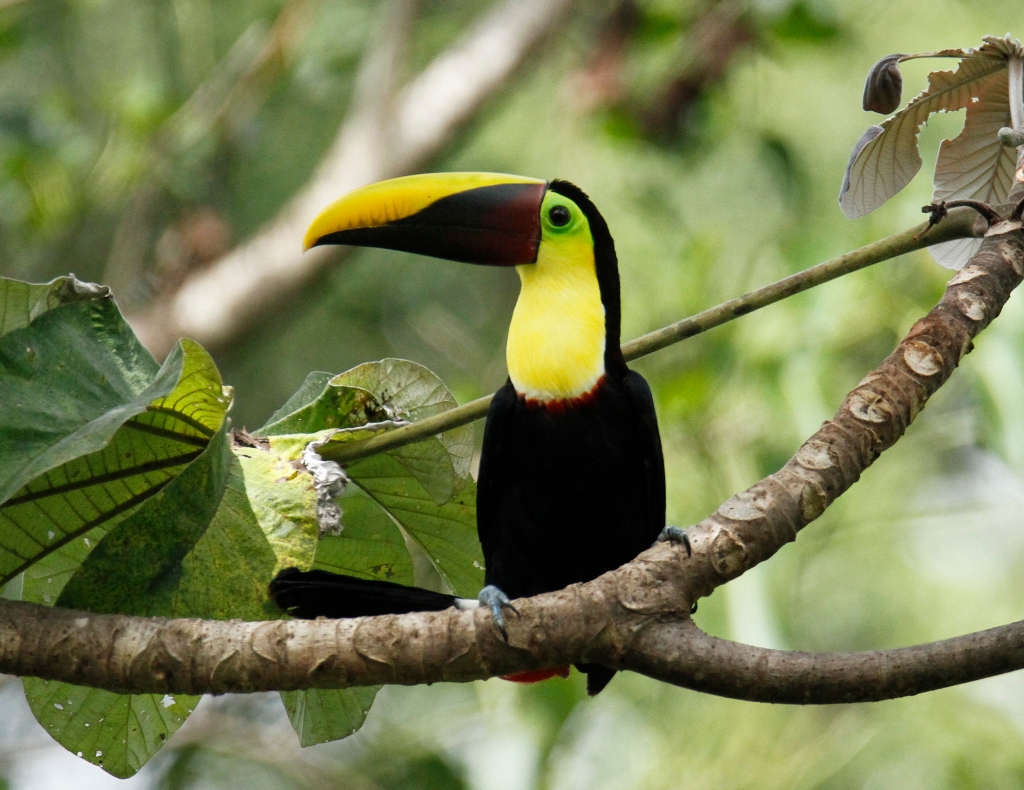Apr 26 – I met the group of 7 from the U.K. at Phoenix Sky Harbor Airport late this afternoon. We made the short transfer to our hotel, as we traveled straight into the setting sun. We had a quick bite, during which time I briefed everyone on plans for the following morning, and then we headed off to get some sleep.
Apr 27 – Our first of many blue-sky mornings in Arizona was today. After breakfast we loaded up our luggage into the vehicle and made our way through the network of Phoenix freeways. Our destination was the Riparian Preserve at Gilbert. We spent over two hours here, roaming the trails, checking ponds and brushy areas for birds. A lovely patch of Saguaro Cactus sits near the parking area at the preserve, so we had a look here first, enjoying the antics of a couple of pairs of Gila Woodpeckers that were nesting in the cactus. A Curve-billed Thrasher popped out from the bushes, as did our first Abert’s Towhees of the trip. Tiny Verdins tended to their messy nests in the Palo Verde trees. Two Black Phoebes were nice to see, as were our first hummingbirds, Black-chinned and Anna’s hummingbirds. Song and White-crowned sparrows played shy at first but revealed themselves to us eventually. Our first Gambel’s Quail were well received, as they called from branches, showing off their flashy ‘topknots’. Doves rocketed overhead in numbers, with Mourning, White-winged and Eurasian Collared-doves present. What we were really here to see though, were the waterbirds, since water, and waterbirds are precious commodities in the desert. Many Mallards were tending to broods of tiny ducklings, and we saw a few other ducks as well such as Northern Shoveler, Ruddy Duck and American Wigeon. A pair of Pied-billed Grebes snoozed near the Ruddy Ducks. A pair of Canada Geese seen shortly after we arrived, flew off, honking loudly as they disappeared behind the trees. Shorebirds, including pink-legged, Black-necked Stilts, Killdeer, Long-billed Dowitcher and Least Sandpiper were nice additions to the list. A couple of Great Egrets and a couple of Snowy Egrets were found, and we had a brief sighting of a Green Heron before it flew off. A single Great Blue Heron sat looking somewhat grumpy in a bush next to the water only a few meters from where we stood. Skimming over the water were Northern Rough-winged Swallows, and there was an Osprey perched on top of a platform. Overhead, three Neotropic Cormorants sailed by, not hanging around for good views. As we walked the trails and pathways here, we added the first mammal species to the list. Rock Squirrels and Desert Cottontails were quite numerous. A couple passing by mentioned they had found a baby turtle on the side of the path. We went to take a look, and I figured it was probably a baby slider. It was getting pretty hot, so we returned to the air-conditioned van and began our drive east towards the town of Globe, where we had lunch at Subway. The locals were quite taken by our group of foreigners visiting their country to look at birds.

South of Globe, and somewhere north of Winkelman, I spotted a Harris’s Hawk soaring overhead. As luck would have it, there was a pull-off nearby. We hopped out of the van and had good looks at the hawk as it circled above us.
The drive to Aravaipa Canyon is quite stunning, with towering cliffs and Saguaro-studded hillsides, lining the valley walls above the creek. The birding was excellent here, even though it was 33 degrees Celsius and mid-afternoon. Our first myiarchus flycatcher of the trip, an Ash-throated Flycatcher, sat on a telephone wire next to the road. A Bewick’s Wren hopped about in a mesquite tree, but I think the Canyon Wren that arrived shortly thereafter, and belted out its beautiful song, stole the show. Colorful birds like Northern Cardinals, Hooded Orioles, Yellow Warbler, and the incredible Vermilion Flycatcher were all seen.

There were plenty of more drab birds around too, such as the subtly beautiful Say’s Phoebe, and the rather nondescript Bell’s Vireo. Overhead, Susan spotted a Common Black-Hawk, and we were quite excited since this was our ‘target’ bird here. The hawk emerged from a hillside with a small lizard in its talons. Moments later, a Red-tailed Hawk and a Common Black-Hawk tousled with each other in the sky above. Gray Hawks also put on a nice show for us, as two adults circled above our van. We had brief encounters with Lucy’s Warbler, which I put down as a ‘leader only’ on the list and a Black-throated Sparrow, which a few people saw. Kate spotted the first Lesser Goldfinches of the trip, feeding in some plants at the base of a rocky hillside. The highlight here, for me, came not in the form of a bird, but in the form of a reptile, a Gila Monster! The rather large yellow and black, venomous reptile climbed slowly up a hill and tried several different routes to get into a nice big hole in the hill. He seemed to have trouble finding the proper route up to the hole, and he eventually went off into the weeds.

The late afternoon drive into Tucson, took us alongside the rather impressive Catalina Mountains, and through the north side of the city. We arrived at our hotel and had an hour before we made our way out for dinner. Our daily ‘tick list’ of birds was 62 species.
April 28 – Another lovely sunny Arizona morning greeted us as we met for some early birding before breakfast. We headed to Agua Caliente Park, a fantastic park with manicured lawns and towering palm trees, ponds and wetlands, and desert scrub habitat all in one. Hooded Orioles sat up in the treetops, enjoying the sun, as did Vermilion Flycatchers, Lesser Goldfinches and Yellow Warbler.

We were rewarded for getting up early with the sighting of a brutish female Cooper’s Hawk that came down for a drink at the edge of the pond. Deep booms from American Bullfrogs came from the edges of the pond, and we saw a couple of these big bruisers. In the desert scrub, Lucy’s Warblers were common, though a bit elusive. Eventually, we did have excellent looks at a couple of Lucy’s as they chased one another about in the mesquite trees nearby. Phainopeplas, always looking as though they’re having a bad hair day, sat atop the mesquites as well. We had our first views of Brown-crested Flycatcher, and excellent views of a pair of Black-throated Sparrows. Our first Ladder-backed Woodpecker of the tour, a male, sat up in the sunlight with his red cap flared up.

We returned to our hotel, had breakfast, and headed off to the supermarket to pick up provisions for lunch. Then, we began our ascent of Mt. Lemmon, in the Catalina Mountains, north of Tucson. Traveling from bottom of Mt. Lemmon at about 3000 feet to the top at over 9000 feet, is said to be the equivalent of traveling from Mexico to Canada, biologically. At the base of the mountains, towering Saguaros cover the hillsides and the temperatures reached 95 degrees F. today. At the top of the mountain, it was just 61 degrees F. and we were in a forest of towering pine, spruce and fir trees, with patches of snow, some quite deep, in the shade of the trees. Our first stop was at Cypress Picnic Area. It was rather quiet here, though we did have nice views of White-breasted Nuthatch, Wilson’s Warbler and Yellow-eyed Junco.
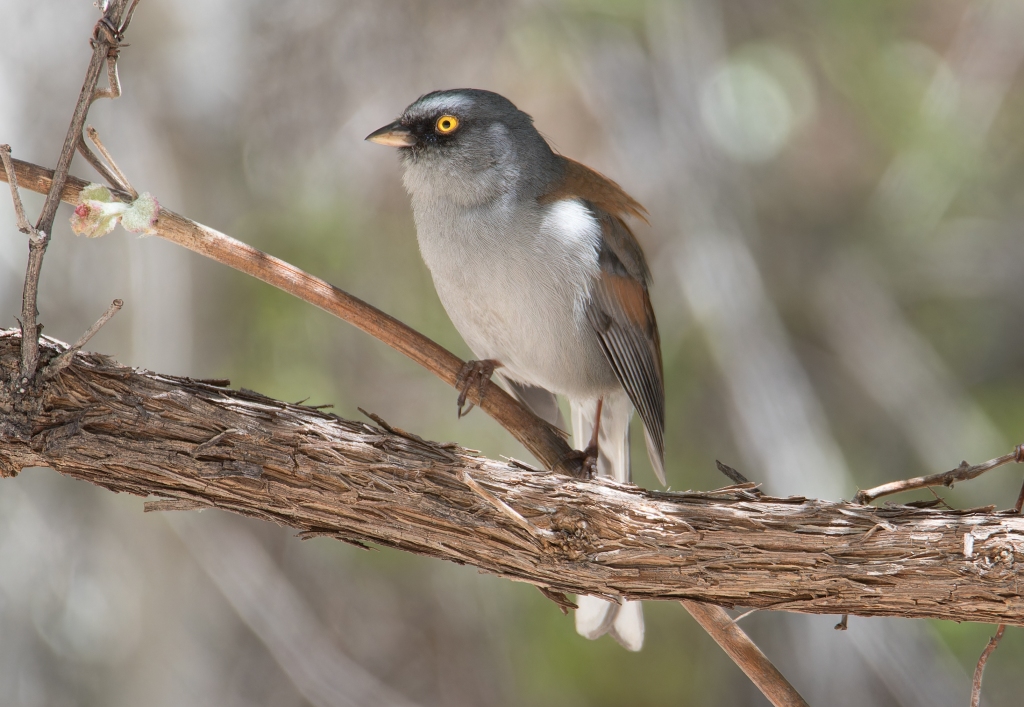
A rather large butterfly, a Two-tailed Swallowtail, was the first butterfly to make it onto our list. Our first Cliff Chipmunk of the tour was noted. Next up, at Chiricahua Pines Picnic Area, we encountered our first troop of Mexican Jays. An Acorn Woodpecker showed nicely for us, as it let out its maniacal, laughing calls. A beautiful male Black-throated Gray Warbler foraged amongst oak leaves right in front of us, as did a Hutton’s Vireo and a pair of Bridled Titmice. A tiny Blue-gray Gnatcatcher played hide and seek and remained mostly hidden by the foliage. John found a couple of Ash-throated Flycatchers in the pine trees, and we had great looks at our first American Robin of the trip, as it hopped about on the ground.
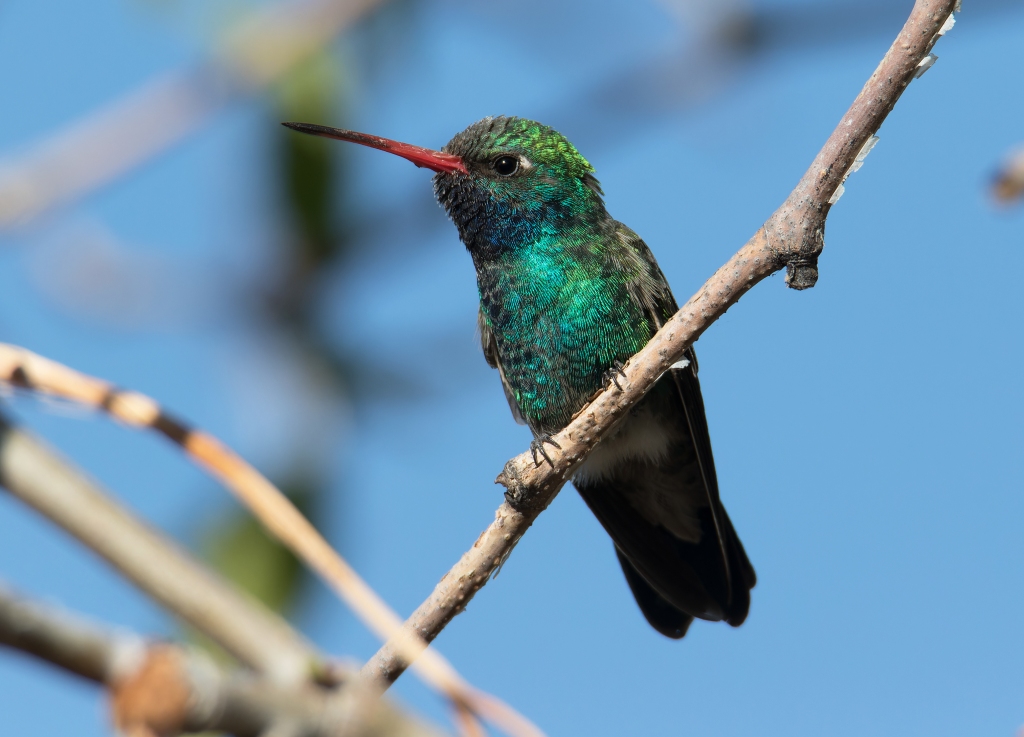
At Bear Wallow, beneath the shade of the towering conifers, we strolled up the canyon, and saw up to 8 gorgeous Red-faced Warblers. When the sun hit their heads, they glowed like embers. We watched a tiny Orange-crowned Warbler take a bath in a trickling stream, and high overhead in a fir, we spotted a Warbling Vireo. Two Hairy Woodpeckers were tracked down after we heard them drumming in the woods. A Brown Creeper, very much a treecreeper look-a-like, hitched its way up the trunks of the trees, and we saw a couple of Hermit Thrushes skulking along the forest floor. Two Mourning Cloak butterflies, called Camberwell Beauties by the British, played with one another, either in a territorial way, or a romantic way. We never did decide. Lunch was enjoyed as we sat on a log next to a pile of snow! A female Broad-tailed Hummingbird, the first of her kind we had seen, kept us entertained for a few moments, and Mountain Chickadees called all around us. A Botha’s Pocket Gopher poked its head out of a freshly dug hole several times, eliciting clicks from cameras each time it appeared. After lunch, we had a pit stop at Box Elder Picnic Area. We were treated to nice views of Western Bluebirds, Grace’s Warbler, and Steller’s Jays!

At the Iron Door Restaurant, across the road from the Mt. Lemmon Ski Hill, we watched for hummingbirds, spotting one each of Broad-tailed and Rivoli’s. A whole kettle of 15 or so Common Ravens played in the winds. At the top of the mountain, we enjoyed amazing views of Tucson below. Male Broad-tailed Hummingbirds were feeding hungrily on nectar in tiny yellow flowers in a gooseberry bush near our van. A short walk yielded great views of a pair of Olive Warblers, a species that sits alone as the sole member in its genus. On our way back down the mountain, we saw a couple of ‘Coue’s’ White-tailed Deer alongside the road. We stopped at Windy Point to take in the amazing rock formations and the view. A pair of Rock Wrens hopped in and out of view amongst the boulders.

After a little break, during which time some folks cooled off in the pool, we went for dinner at Applebee’s.
April 29 – Our first stop this morning was at Sabino Canyon. By the time we arrived, it was already hot. We took a stroll on a trail through the Sonoran Desert habitat. Birds included Brown-crested Flycatcher, Verdin, White-winged Doves, Phainopepla, House Finch, and our first Cactus Wrens of the tour. There were perhaps 4 of them, chasing one another through the cactus, wagging their long tails.

I heard a Greater Roadrunner giving its bill snapping call and spotted the bird deep within a bush with dense foliage. We could just see bits of his head and bill. Anne shouted, ‘Snake!’. A Western Diamondback Rattlesnake slithered slowly across the sandy ground and out of sight. In addition to the snake, there were all sorts of speedy little lizards, including a Zebra-tailed Lizard. We took the tram ride up into the canyon, which is extremely scenic. Listening on earbuds, we could hear the narration about the wildlife and history of the canyon. On our way back down, some of us hopped off the tram to walk down a bit and see what we could find, while others rode back down to the cool shady areas around the headquarters. Those of that walked down saw a few birds, though not too many. There were Northern Cardinals, Brown-crested Flycatcher, Lucy’s Warbler, singing Bell’s Vireos, and our first Costa’s Hummingbird of the trip, was a male. The temperatures were hotter than average today, so we found shade as often as possible.
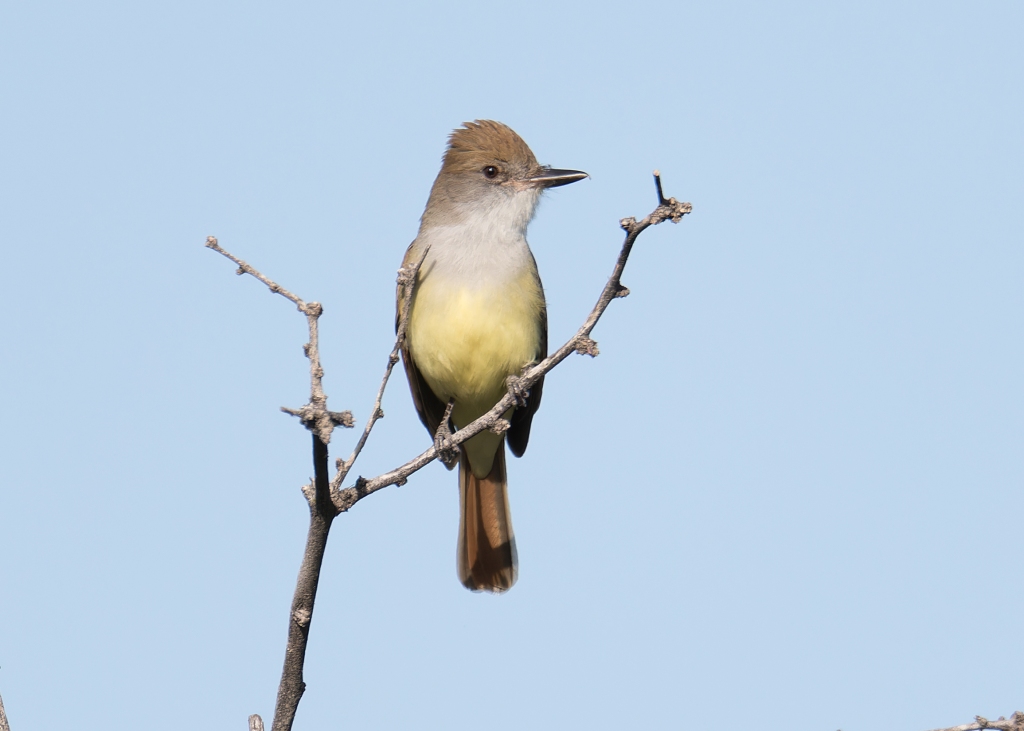
After we met the rest of the group, we headed for lunch at Subway, then made our way to the west side of Tucson, and to the Sonoran Desert Museum. Temperatures as we pulled into the museum parking lot had reached 99 degrees F. We didn’t spend as much time here as we might have, because of the heat. Walking some trails, we did see several Cactus Wrens, Arizona’s state bird. There were also Hooded Oriole, Abert’s Towhee, Wilson’s Warbler, Lesser Goldfinch, and overhead, our first Black Vultures of the trip. Anne added Pyrrhuloxia to our trip list, as she saw one that nobody else managed to get eyes onto. One of the staff members at the museum pointed out a wild Sonoran Spiny-tailed Iguana to us. We also added another mammal to the trip list at the museum, a wild Round-tailed Ground-Squirrel. We met inside the café and enjoyed some refreshing ice cream before heading towards Green Valley, our home base for the next two nights.

April 30 – After breakfast we visited a neighborhood of Green Valley, hoping to perhaps catch a glimpse of a Gilded Flicker. Along the way, John spotted a Greater Roadrunner sitting up in a bush alongside the road. Unfortunately, no Gilded Flicker was to be seen this morning, however, the area was quite rich in bird life. We saw our first Rufous-winged Sparrow of the tour, as it sang from a treetop. A Cooper’s Hawk circled overhead and paused for a moment atop a telephone pole. Other species seen included Lark Sparrow, Curve-billed Thrasher, Gila Woodpecker, Northern Cardinal and Brown-crested Flycatcher.
We picked up lunch at the supermarket and headed up into the Santa Rita Mountains and Madera Canyon. A short hike up the Carrie Nation Trail proved to be very productive. We saw a pair of Elegant Trogons, one of Arizona’s most sought-after bird species, inspecting a nest cavity in a large sycamore tree. The male gave his barking call from a nearby branch, while the female stuck her head inside the cavity and took a look. She flew off, and the male entered the cavity, and he called several times from within the hole. Mexican Jays accompanied us as we walked along, and a pair of Painted Redstarts appeared for a few moments before disappearing. House Wrens gave us a particularly good showing, as did a pair of Hepatic Tanagers, our first for the tour.
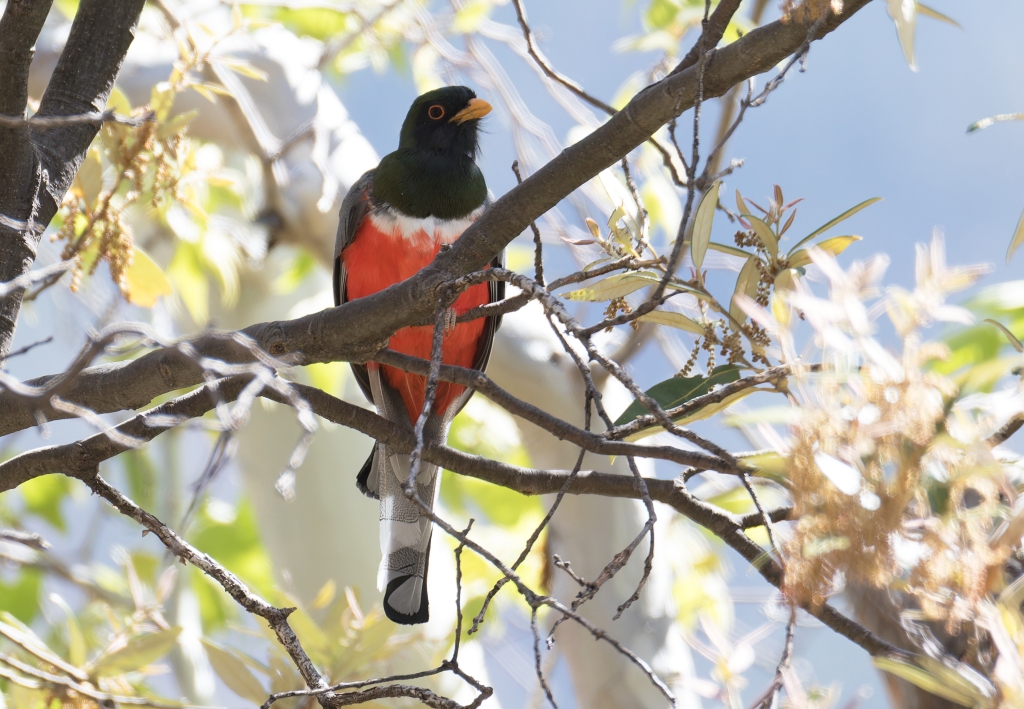
We explored areas along the creek further down in the canyon, finding more good birds like Brown-crested Flycatchers, many Acorn Woodpeckers and a single Arizona Woodpecker. Our first ‘Audubon’s’ Yellow-rumped Warblers of the tour were found here, as well as Bridled Titmouse. Arizona Gray Squirrel was a new addition to the trip mammal list. We had a picnic lunch under the shade of the Mexican Blue Oak trees, and then we visited feeders at Santa Rita Lodge. Here, there were many birds coming to feed, including hummingbirds, such as Rivoli’s, Black-chinned and Broad-tailed hummingbirds. There were a number of Mexican Jays, as well as half a dozen or so Wild Turkeys! Acorn Woodpeckers seemed to be everywhere. A young male Bronzed Cowbird, with a bright red eye, visited the feeders, and was our first one for the tour.

We headed back down to Green Valley for a ‘siesta’ before having an early dinner. After dinner we headed back to Madera Canyon. We waited with about a dozen other people outside of the owner of the Santa Rita Lodge’s private home. He has an Elf Owl that nests in a telephone pole on his property. We waited, patiently, and eventually the female Elf Owl poked her head out of the nest and took a long look at us. As it got darker, the male flew in and we had fantastic views of him as he perched on a branch with a caterpillar in his bill. To finish off the night, we had a good view of another owl species, a Whiskered Screech-Owl. A Mexican Whip-poor-will called several times up the canyon and we would have to be satisfied with just hearing this species.

May 1 – We checked out of our hotel in Green Valley and headed up towards the Santa Rita Mountains one more time. We stopped first at Florida Wash, where we walked a short distance up along the mostly dry creek bed. Vermilion Flycatchers kept us entertained as we strolled up through the mesquite woodland, however, the real highlight here was a somewhat out of place Townsend’s Solitaire! In a bit of grassland nearby we watched a Botteri’s Sparrow sing, as we spied on him through the scope. A stroll along the path in lower Madera Canyon produced a few nice sightings. We saw our first colorful Western Tanager, a male. On a hillside, an Olive-sided Flycatcher sat atop a tall yucca. We glimpsed our first Canyon Towhee of the tour, and as we were leaving, a ‘Turkey Vulture’ materialized into our one and only Zone-tailed Hawk of the trip.

We picked up lunch at the supermarket and then made our way to Montosa Canyon, where we hoped to find Five-striped Sparrow, a rare and local species found only in a couple of locations north of the Mexican border. We had lunch here, as we waited for the sparrow to appear. It did appear, but only for a moment, and unfortunately, I was the only person who saw it. Other birds here, however, included White-throated Swifts, Costa’s Hummingbird, a lovely male Hooded Oriole and our one and only Woodhouse’s Scrub-Jay of the tour. On our way down, we paused in the desert to look at our first Pyrrhuloxias, and we were also treated to nice views of a Greater Roadrunner.

A quick stop at the Amado Wastewater Treatment Plant produced some good birds for the daily tick list. There were Ruddy Ducks, Mexican Ducks, Black-bellied Whistling-Ducks and a single male Ring-necked Duck here. Several Spotted Sandpipers and a Killdeer were noted. Overhead was a Black Vulture, a Swainson’s Hawk and a Barn Swallow.
A walk up the Santa Cruz River did not produce the Rose-throated Becard we had hoped for. Apparently the becard’s nest had blown down in a windstorm and the birds were not easy to find after that. Still, we found over 30 species of birds on our walk, including Abert’s Towhee, Summer Tanager, a Common Yellowthroat, and best of all, a Green Kingfisher, though the kingfisher was seen by just 3 ppl. Carrying on, we ended up in the ‘one horse town’ of Patagonia, where we checked into our accommodation and went for dinner at the Wagon Wheel Saloon.
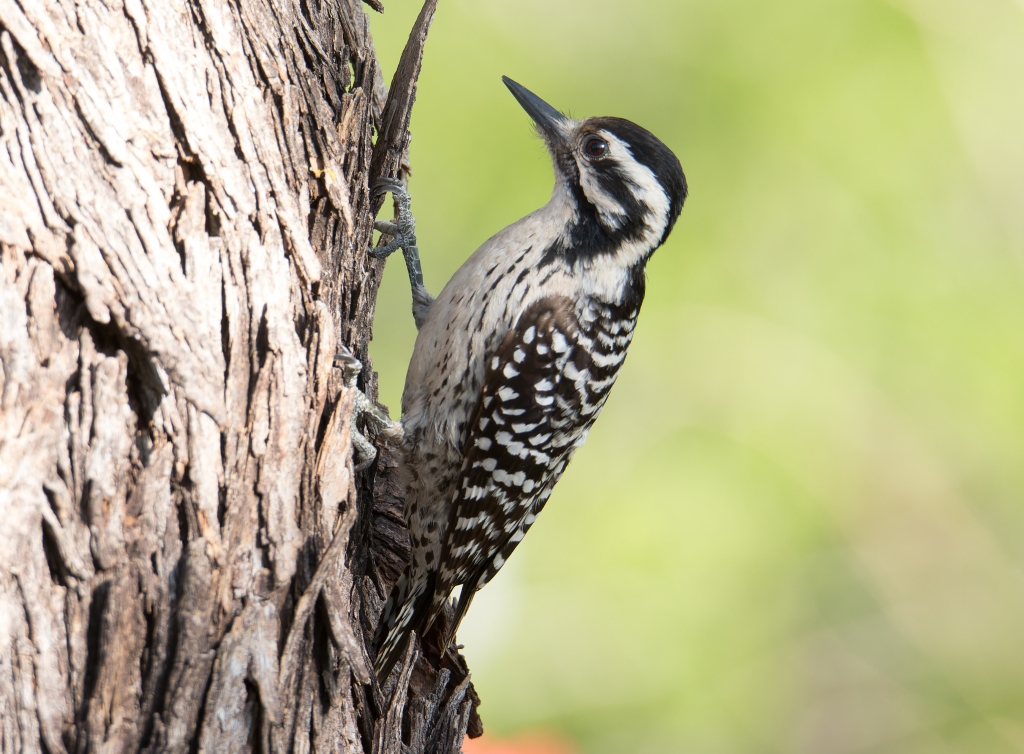
May 2 – Cool temperatures, sunny skies and noisy Barn Swallows welcomed us as we emerged to do some pre-breakfast birding at the famous Patagonia Roadside Rest Stop. As soon as we arrived, I could hear a Rufous-capped Warbler singing on the hillside above us. This rare visitor from Mexico had been found a day or two before and we were more than happy to connect with it. We enjoyed lovely views of the warbler as it foraged and sang this morning. A Rock Wren showed itself nicely this morning, and we had good views of our only Northern Beardless-Tyrannulet down along Sonoita Creek as well.

Back in Patagonia we had a lovely breakfast at the Gathering Grounds before heading out once again, this time to Patagonia Lake State Park. We spent the rest of the morning here, racking up an impressive list of nearly 60 species! On the lake were Ruddy Ducks and a couple of Pied-billed Grebes, as well as Neotropic Cormorants, a Double-crested Cormorant and American Coots. A Great Blue Heron, and a Snowy Egret were observed too. The area is excellent for raptors, and we saw both Turkey and Black vultures, as well as Gray Hawk, Red-tailed Hawk and a Common Black Hawk. Vermilion Flycatchers kept us entertained, and we had our first Cassin’s Kingbird of the tour. Also new were both Inca Dove and Common Ground-Doves. Yellow-breasted Chats were singing all over the place in the riparian woodlands, and we were lucky to catch views of one or two of them. Our first Bullock’s Oriole of the trip appeared in a treetop, alongside a male Yellow Warbler. Along the river, we saw a couple of new butterflies, a Fatal Metalmark and a group of Marine Blues.

After a siesta, we gathered and headed over to the Paton’s Center for Hummingbirds, where we spent the rest of the afternoon watching feeders. The highlight was the center’s signature bird, a Violet-crowned Hummingbird, but there were plenty of other birds to see as well. Gambel’s Quail posed for the photographers, as did White-breasted Nuthatches, Bewick’s Wren, Curve-billed Thrasher, Lark Sparrows, White-crowned Sparrows and a single White-throated Sparrow. We enjoyed great looks at male and female Lazuli Buntings, as well as Black-headed Grosbeaks and the usual, but beautiful Northern Cardinals and Summer Tanagers. Dinner was at the Wildhorse Saloon.

May 3 – Before breakfast we made the 45-minute drive to Pena Blanca Lake, west of Nogales. Here, we hoped to find another local rarity, a Least Grebe. As we searched for the grebe we found other goodies like Green Heron, Black Phoebe, Brown-crested Flycatcher and Violet-green Swallow. Once we reached a viewpoint, I spotted the grebe in the distance, so we drove over to take a look. The grebe showed nicely, giving us views of its gray plumage, thin black bill, and staring yellow eye.
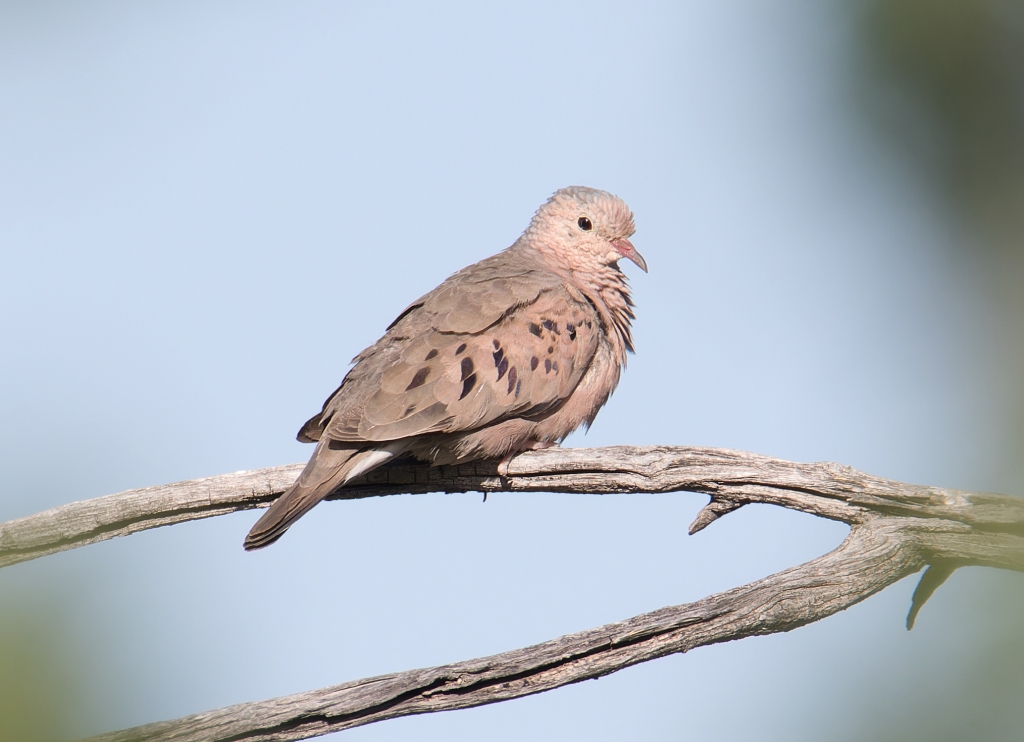
We had breakfast again, at our favorite establishment in Patagonia, the Gathering Grounds. While we waited for our to-go lunches, we explored a little stretch of Sonoita Creek along Blue Haven Road. It was a nice stroll, though we didn’t find anything new here.
We picked up lunch and then drove east to the Sonoita Grasslands at Las Cienegas. Here, we explored the grassland habitat, picking up some nice birds such as Loggerhead Shrike, Horned Lark, Western Kingbird, Chihuahuan Raven, loads of Lark Sparrows, and perhaps the highlight, a pair of lovely Chihuahuan Meadowlarks. Several Pronghorn Antelope, North America’s fastest land mammal, were seen here today.
Once we made it Sierra Vista, we checked into our hotel and then made our way to the edge of the Huachuca Mountains at Ash Canyon Bird Sanctuary. Here, we were given a private tour by hummingbird expert, Sheri Williamson. Hummingbirds included Black-chinned, Anna’s, Broad-tailed, Broad-billed, a Rufous, and the star attraction at Ash Canyon, a male Lucifer Hummingbird. Other species came in to feed as well, such as Bullock’s, Scott’s and Hooded orioles, Gila Woodpeckers, Canyon Towhee, Lesser Goldfinch and Lazuli Bunting. A cotton rat of some sort peeked out from a brush pile, and Sheri explained there are 3 species of cotton rate that can be found in the area. Dinner this evening was at the Olive Garden.

May 4 – After picking up our lunch, we headed to Carr Canyon Road and began the ascent of the only road that travels up into the higher elevations of the Huachuca Mountains. The road is rough, winding and steep, but worth the effort. Along the way up, we had wonderful views of Sierra Vista surrounding areas below. We spent the next couple of hours birding at the Reef Townsite Campground, at over 8,000 feet elevation. It didn’t take us long to find our target bird for the morning, the Buff-breasted Flycatcher. This, the smallest of the Empidonax flycatchers, can be found in the USA, only in the Huachuca Mountains! We saw several of these tiny buffy-fronted flycatchers amongst the forests today.

Another of our target species, the Greater Pewee, was also found here at Reef Townsite. We watched a couple of these larger, slightly crested flycatchers, for several minutes as they foraged for insects. Finally, we saw our first Plumbeous Vireos of the trip, and our first Virginia’s Warbler played a little hard-to-get, but we eventually saw it. We had more sightings of birds like Painted Redstart, Red-faced and Grace’s warblers, Hermit Thrush and Bushtit. We then began the trek back down the mountain, stopping at a picnic site near the bottom. On the way, a Sonoran Whipsnake crossed the dirt road in front of our van. At the Carr Canyon Picnic site, we were accompanied by Mexican Jays that tried to snatch our lunches. One final stop produced the only Eastern Bluebird of the tour, and we were then notified of a wildfire burning nearby so we vacated the area rather promptly.

At Ramsey Canyon Preserve, we enjoyed a nice hike up to the top of the Bledsoe Loop. Though we didn’t find the Northern Pygmy-Owls we had hoped to find, we did see some other interesting birds. We had a lovely Sulphur-bellied Flycatcher, as well as a brief encounter with another Elegant Trogon. More Plumbeous Vireos were seen, along with Hutton’s Vireo as well. We watched a Painted Redstart tend to its nest on the ground on a hillside near the path. A butterfly, the Nabokov’s Satyr, and a lizard, the Clark’s Spiny Lizard were added to the burgeoning list of critters we had seen. We enjoyed dinner at Applebee’s before heading off to get a good night’s rest.

May 5 – After picking up lunch at Subway, we made our way to Miller Canyon where we paid a visit to the Beatty’s Guest Ranch. Hummingbird feeders here were abuzz with activity. There were Rivoli’s, Black-chinned, Broad-tailed, Broad-billed and Anna’s hummingbirds in attendance. Some of us walked up the canyon, finding a few interesting species including Hepatic Tanager, Painted Redstart, Sulphur-bellied Flycatcher and we heard, but did not see, a Cordilleran Flycatcher. Our one and only Arizona Sister butterfly was seen here in Miller Canyon. In the ponds at the Beatty’s property we saw several Lowland (Chiricahua) Leopard Frogs, and a Black-necked Garter-Snake.

We drove to the San Pedro River, a little bit east of Sierra Vista, and we had lunch at San Pedro House beneath the shade of a massive cottonwood tree. Feeders around the house had some good birds, including Pyrrhuloxia and our only Blue Grosbeak of the tour. There were other species about as well, including Gila Woodpecker, Black-chinned Hummingbirds, Curve-billed Thrasher, House Finches and more.
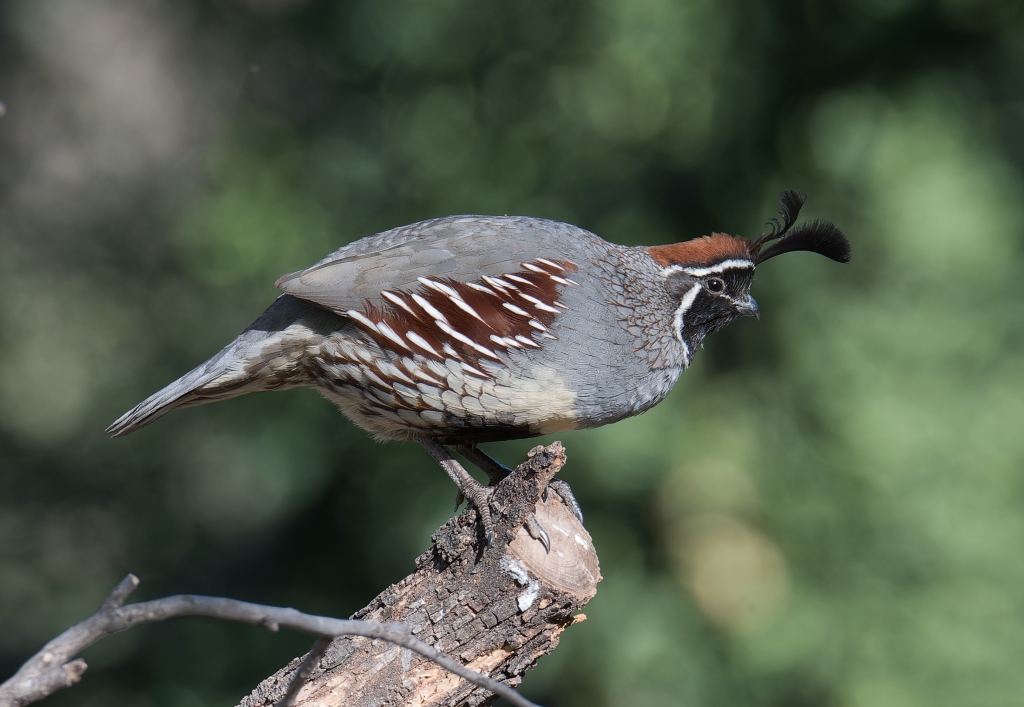
The drive to Portal was briefly interrupted by a stop to fuel up the van in the border town of Douglas. Before we got to Portal, we checked out an old structure where Great Horned Owls sometime nest. There were no owls to be seen, but we did see a rather large Bull Snake on the road! Once we arrived in Portal, we checked into the lodge and then took a stroll along the street to see what we could find. Portal is a tiny hamlet with only a few homes, the lodge, and a post office along the main street. Many of the residents put out bird feeders and allow birders to peer into their gardens. We found such a place and happily connected with our first, and only, Blue-throated Mountain-gems of the tour. Other feeder birds included Inca Dove, Black-headed Grosbeak, Pine Siskin, Northern Cardinal, Lesser Goldfinch, Lazuli Bunting, Acorn Woodpecker and Western Tanager to name a few.

After dinner some of us took a walk along the street to see if we could find any owls. There was a Cinco de Mayo celebration happening, so it was rather action packed, but a short distance down the street, it was nice and quiet. We heard several Elf Owls calling and we saw an adult Great Horned Owl as it hooted loudly from the chimney of one of the houses. We then spotted a known nest in a large sycamore tree near the lodge, and there were two fluffy little Great Horned Owl babies peering out. Another fantastic day.

May 6 – First thing this morning we made our way from Portal to the New Mexico state line. We hoped to find a few interesting desert birds this morning before breakfast, and we succeeded. Several Scaled Quail were noted as we traveled from Portal to New Mexico, a first sighting for us on this trip. Once at Gin Road, we looked and listened for Bendire’s Thrashers. First, we spotted a Curve-billed Thrasher singing from the top of a tree in the distance. Then we saw a Cactus Wren sitting atop a yucca singing away. Finally, I spotted a Bendire’s Thrasher singing from the top of a tall yucca, and we enjoyed scope views of this rather rare and uncommon thrasher species. New for the mammal list was an Antelope Jackrabbit sitting quietly in the shade beneath a mesquite tree. We also saw three Coyotes cross the road early this morning, our only for the tour. We had earned our breakfast, so off we went to the Rodeo Store and Café, in Rodeo, NM.
After breakfast we returned to Portal, picked up our bagged lunches and began the journey up into the Chiricahua Mountains. The road was bumpy and twisty, but still in better condition that the road up to Carr Canyon we had traveled a couple days earlier. We headed straight up to over 8,000 feet elevation, enjoying lovely views along the way. Our target bird here, was Mexican Chickadee, a species that can be found in the USA only in the Chiricahua Mountains. It didn’t take us too long to find one, up in the boughs of firs and pine trees. Other species here included House Wren, Yellow-eyed Junco, Steller’s Jay, Northern Flicker (Red-shafted), and a Ruby-crowned Kinglet. We had lunch near Rustler Park, and Steller’s Jays kept us entertained as they came in to pick up scraps from beneath the tables. A Greater Pewee, and a pair of lovely Western Tanagers were also busily foraging in the little gully below where we ate our lunch. Sue and I spotted a Hairy Woodpecker pecking away at the base of a burned tree. We descended via a slightly different route, that took us down through the south fork of Cave Creek Canyon. We spent a little time here, though it was a bit quiet at that time of day. Anne spotted a male Elegant Trogon, our fourth for the trip, down along the banks of Cave Creek!
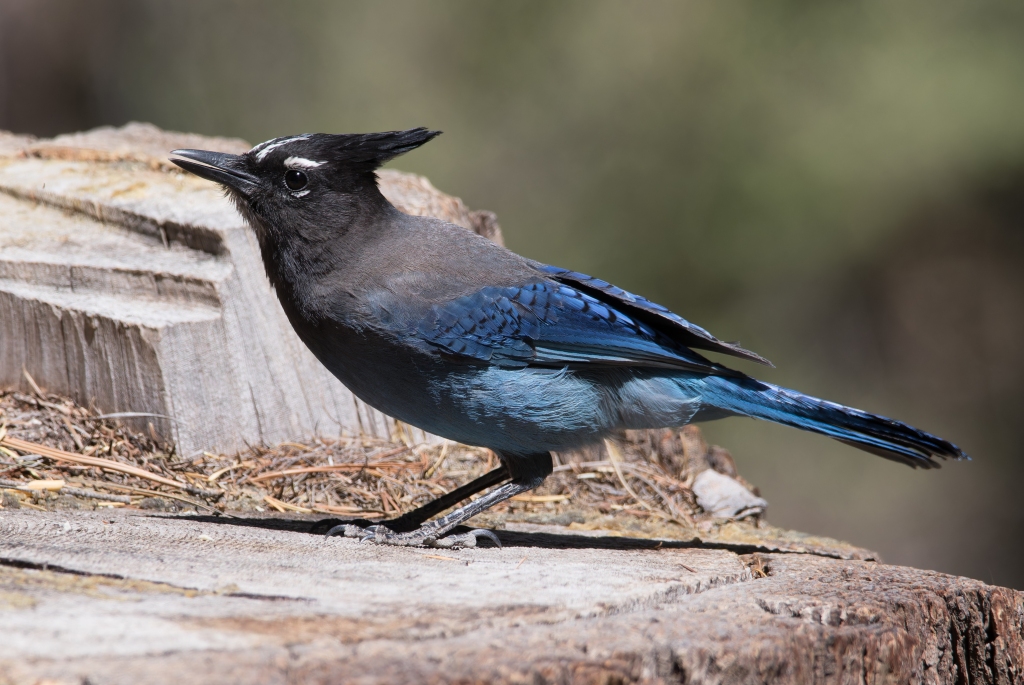
Back in Portal, some decided to take a siesta, while the rest of us headed over to another set of feeders off Foothills Rd. Here, we hoped to spot another rare and elusive thrasher, Crissal Thrasher. We sat comfortably in seats near the feeders and watched the bonanza of birds come in. There were Black-throated Sparrows, Pyrrhuloxias, Northern Cardinals, Scott’s, Hooded and Bullock’s orioles, House Finches, Lesser Goldfinches, Gambel’s Quail (with babies), and Lazuli Buntings. Hummingbirds included Black-chinned and Broad-billed, and we also had a good look at a Common Ground-Dove as it called nearby. It was nearly time to return to town for dinner, and I stated, ‘We’ll give the thrasher 15 more minutes to come in before we have to leave.’ Pretty much on the 15th minute, two Crissal Thrashers, which appeared to be young birds, came in and put on a nice show for us.

Our final dinner at the Portal Lodge was good, as per usual. We headed off to get some rest before the long travel day ahead.
May 7 – It was our last morning in Arizona, and we headed out bright and early to look for Juniper Titmouse at the Paradise Cemetery. It didn’t take us long to locate a couple of these rather drab, but charismatic titmice, calling away amongst the juniper trees. We also had our first good looks at a couple of Black-tailed Gnatcatchers this morning, as they harassed a gorgeous male American Kestrel.

Back in Portal, we gathered our stuff from the rooms in the lodge and checked out. Today was a travel day as we made our way from Portal back to Phoenix, a drive of about 5 hours. We stopped, along the way, at the Willcox Water Treatment Plant, or sewage ponds, as birders better know them. Our final stop of the tour netted us about 15 new species, which is quite amazing. There were shorebirds here, including Western Sandpipers, Semipalmated Plover, Lesser Yellowlegs, Wilson’s Phalaropes and two Red-necked Phalaropes, and a number of lovely American Avocets. A young Peregrine Falcon put on a nice show as it tried to catch shorebirds and swallows here. At least 3 White-faced Ibis foraged along the shore of the ponds, and we saw a lonely Cattle Egret as well. Eared Grebes, along with Ruddy Ducks, Mexican Ducks, Gadwall, American Wigeon, Cinnamon Teal, Green-winged Teal and Blue-winged Teal were all noted. Our only Savannah Sparrow of the trip foraged along the edge of the pond, and we had just our second sighting of Chihuahuan Meadowlark as well. We stopped in for lunch at Benson, before continuing along to Phoenix, arriving around 4 PM. We said our farewells and I dropped everyone off. Total species count for the trip was 194, including leader only’s, and 184 for the official tour total.
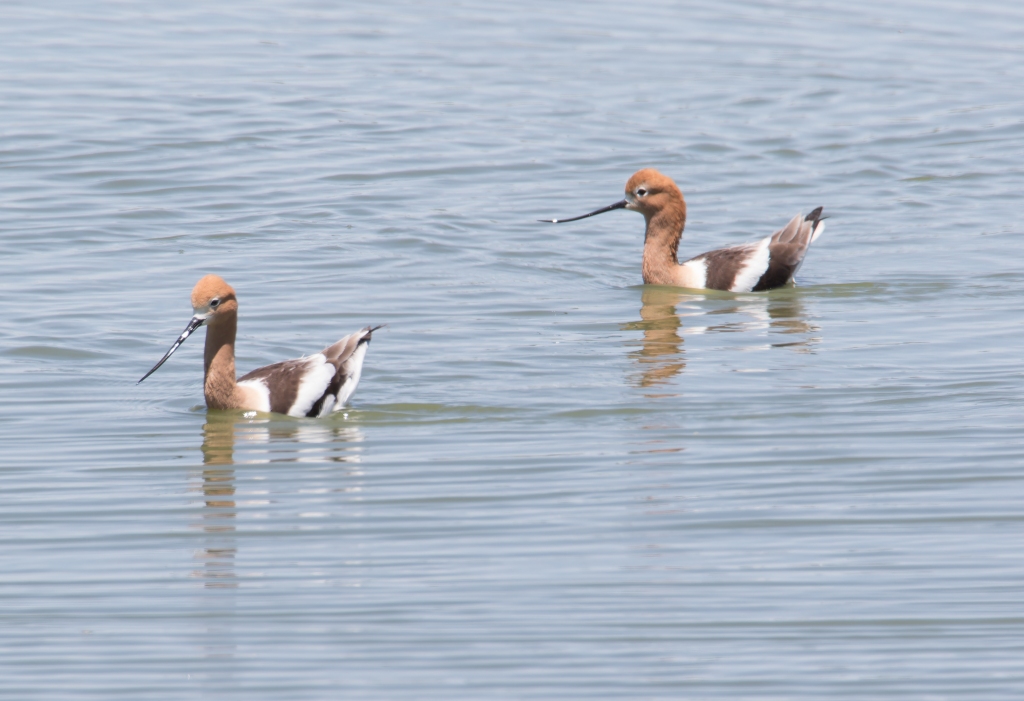
Bird List: Black-bellied Whistling-Duck; Canada Goose; Blue-winged Teal; Cinnamon Teal; Northern Shoveler; Gadwall; American Wigeon; Mallard; Mexican Duck; Green-winged Teal; Ring-necked Duck; Ruddy Duck; Scaled Quail; Gambel’s Quail; Wild Turkey; Least Grebe; Pied-billed Grebe; Eared Grebe; Rock (Feral) Pigeon; Eurasian Collared-Dove; Inca Dove; Common Ground-Dove; White-winged Dove; Mourning Dove; Greater Roadrunner; White-throated Swift; Rivoli’s Hummingbird; Blue-throated Mountain-gem; Lucifer Hummingbird; Black-chinned Hummingbird; Anna’s Hummingbird; Costa’s Hummingbird; Rufous Hummingbird; Broad-tailed Hummingbird; Broad-billed Hummingbird; Violet-crowned Hummingbird; Sora; American Coot; Black-necked Stilt; American Avocet; Semipalmated Plover; Killdeer; Least Sandpiper; Western Sandpiper; Long-billed Dowitcher; Wilson’s Phalarope; Red-necked Phalarope; Spotted Sandpiper; Lesser Yellowlegs; Double-crested Cormorant; Neotropic Cormorant; Great Blue Heron; Great Egret; Snowy Egret; Cattle Egret; Green Heron; White-faced Ibis; Black Vulture; Turkey Vulture; Osprey; Cooper’s Hawk; Common Black-Hawk; Harris’s Hawk; Gray Hawk; Swainson’s Hawk; Zone-tailed Hawk; Red-tailed Hawk; Whiskered Screech-Owl; Great Horned Owl; Elf Owl; Burrowing Owl; Elegant Trogon; Green Kingfisher; Acorn Woodpecker; Gila Woodpecker; Ladder-backed Woodpecker; Hairy Woodpecker; Arizona Woodpecker; Northern Flicker; American Kestrel; Peregrine Falcon; Northern Beardless-Tyrannulet; Olive-sided Flycatcher; Greater Pewee; Western Wood-Pewee; Hammond’s Flycatcher; Gray Flycatcher; Cordilleran Flycatcher; Buff-breasted Flycatcher; Black Phoebe; Say’s Phoebe; Vermilion Flycatcher; Dusky-capped Flycatcher; Ash-throated Flycatcher; Brown-crested Flycatcher; Cassin’s Kingbird; Thick-billed Kingbird; Western Kingbird; Bell’s Vireo; Hutton’s Vireo; Plumbeous Vireo; Warbling Vireo; Loggerhead Shrike; Steller’s Jay; Woodhouse’s Scrub-Jay; Mexican Jay; Chihuahuan Raven; Common Raven; Mountain Chickadee; Mexican Chickadee; Bridled Titmouse; Juniper Titmouse; Verdin; Horned Lark; Northern Rough-winged Swallow; Violet-green Swallow; Barn Swallow; Cliff Swallow; Bushtit; Ruby-crowned Kinglet; Red-breasted Nuthatch; White-breasted Nuthatch; Pygmy Nuthatch; Brown Creeper; Blue-gray Gnatcatcher; Black-tailed Gnatcatcher; Rock Wren; Canyon Wren; House Wren; Bewick’s Wren; Cactus Wren; European Starling; Curve-billed Thrasher; Bendire’s Thrasher; Crissal Thrasher; Northern Mockingbird; Western Bluebird; Eastern Bluebird; Townsend’s Solitaire; Hermit Thrush; American Robin; Phainopepla; Olive Warbler; House Sparrow; House Finch; Red Crossbill; Pine Siskin; Lesser Goldfinch; Rufous-winged Sparrow; Botteri’s Sparrow; Five-striped Sparrow; Black-throated Sparrow; Lark Sparrow; Yellow-eyed Junco; White-crowned Sparrow; White-throated Sparrow; Savannah Sparrow; Song Sparrow; Canyon Towhee; Abert’s Towhee; Rufous-crowned Sparrow; Spotted Towhee; Yellow-breasted Chat; Chihuahuan Meadowlark; Hooded Oriole; Bullock’s Oriole; Scott’s Oriole; Red-winged Blackbird; Bronzed Cowbird; Brown-headed Cowbird; Great-tailed Grackle; Orange-crowned Warbler; Lucy’s Warbler; Virginia’s Warbler; Common Yellowthroat; Yellow Warbler; Yellow-rumped Warbler; Grace’s Warbler; Black-throated Gray Warbler; Townsend’s Warbler; Rufous-capped Warbler; Wilson’s Warbler; Red-faced Warbler; Painted Redstart; Hepatic Tanager; Summer Tanager; Western Tanager; Northern Cardinal; Pyrrhuloxia; Black-headed Grosbeak; Blue Grosbeak; Lazuli Bunting.
Mammal List: Rock Squirrel; Round-tailed Ground-Squirrel; Cliff Chipmunk; Arizona Gray Squirrel; Cotton Rat sp; Botha’s Pocket Gopher; Black-tailed Jackrabbit; Antelope Jackrabbit; Desert Cottontail; Coyote; Collared Peccary; White-tailed Deer; Pronghorn
Reptile and Amphibian List: Lowland Leopard Frog; American Bullfrog; Red-eared Slider; Sonoran Spiny-tailed Iguana; Ornate Tree Lizard; Zebra-tailed Lizard; Clark’s Spiny Lizard; Gila Monster; Black-necked Garter Snake; Coachwip; Sonoran Whipsnake; Western Diamondback Rattlesnake; Bull Snake.
Butterfly List: Two-tailed Swallowtail; Mourning Cloak; Empress Leila; Red-spotted Purple; Common Buckeye; Fatal Metalmark; Marine Blue; Nabokov’s Satyr; Arizona Sister.




